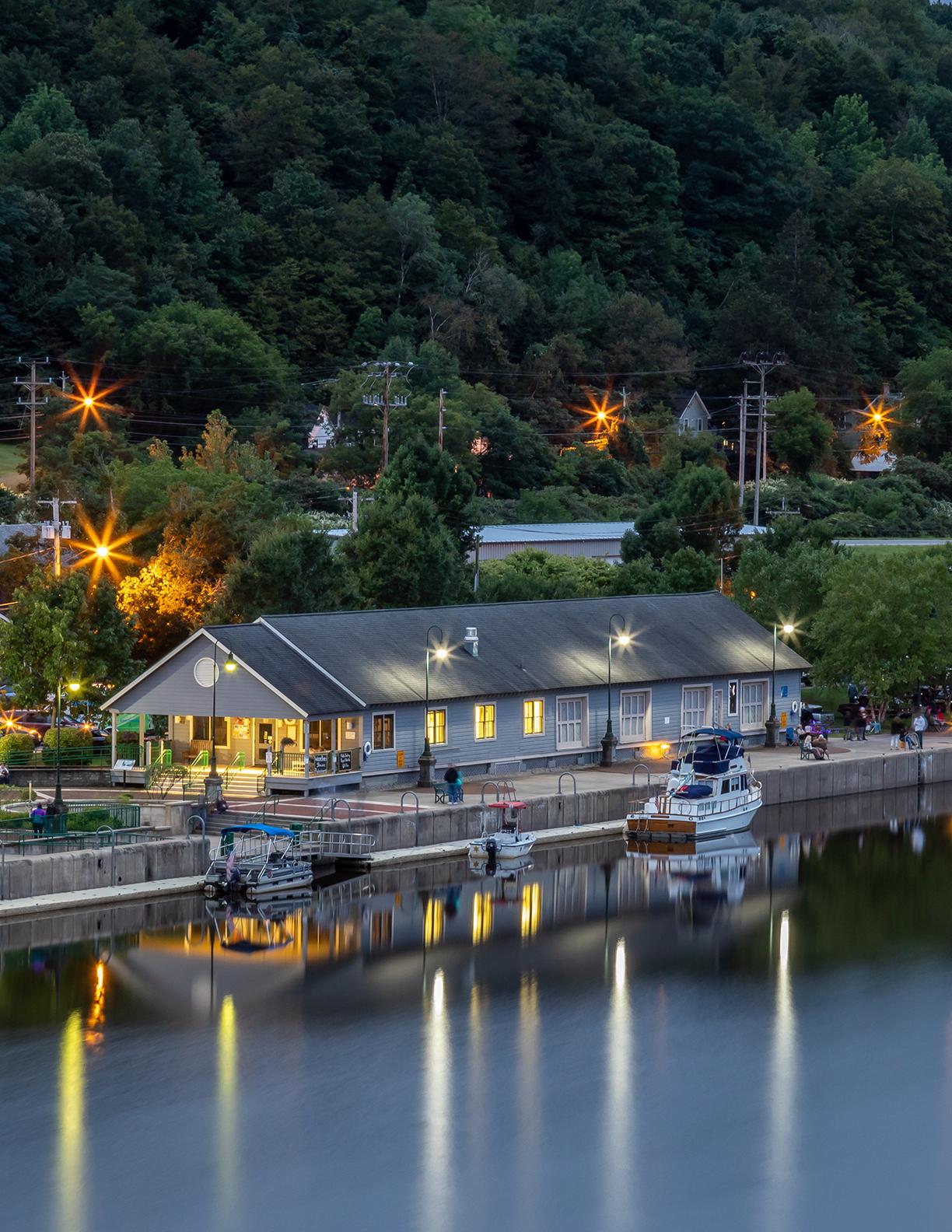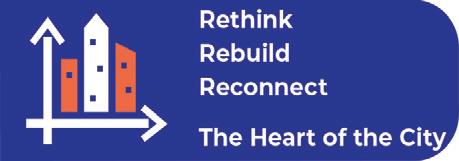
35 minute read
Downtown Identification
Proposed DRI Boundaries

Advertisement
Detail the boundaries of the targeted downtown area or neighborhood, keeping in mind that there is no minimum or maximum size, but that the area should be concentrated and well-defined. Neighborhoods beyond traditional central business districts are eligible if they can meet other criteria making them ripe for investment. Include a map that clearly delineates the area to be included in the downtown revitalization area.
The Downtown Waterfront District, and the City’s proposed DRI Boundary, combine two historically separate districts into a unified, vibrant City center, connecting Main Street and the Canal Place waterfront as the central business district. Each of the City’s downtown components enjoy a very distinct ambience, historic assets, and character.
Main Street embodies Little Falls’ authenticity and distinctive downtown character with its iconic storefront canopies, well-preserved collection of 19th century buildings and its historic 3-1/2 story, Classic Revival City Hall. It’s a post-card perfect setting that continues to attract visitors, cinematographers and movie producers. Main Street is anchored on the west side by Furnace Street and State Route 5, and on the east side by State Route 169 and State Route 5.
Canal Place was originally the industrial hub of the City with mills, manufacturing and warehousing along the Erie Canal and Mohawk River. Over the years, the decline of the industrial age and resulting loss of manufacturing opened up this historic area up to new development along the waterfront as a robust arts & cultural district with galleries, retail shops, office spaces, residential apartments, dining, lodging and recently artisan beer crafting. Today, residents and visitors shop, lodge, dine and seek entertainment equally between Main Street and Canal Place, a short two-blocks away. Canal Place is anchored on the west side by Elizabeth Street, W. Mill Street and State Route 167 (to 5s), and on the east side by E. Mill Street and S. William Street.

DRI Proposed Project Map
To support the City’s expanding economic vision, the Downtown Waterfront District will need to maintain a diverse mix of office, residential and entertainment options, improve transit and pedestrian access into and within the commercial core, and reconnect pedestrian/bike transit across the Erie Canal and Mohawk River.
The Downtown District (Main Street) focuses on professional businesses, banking, retailing, grocery, movie theater, bakery, meat market, restaurants, city services and residential lofts with less emphasis on greenspace. The street is typical of fast-paced pedestrian movement in urban settings. Walkability, e-Mobility, lighting and parking are of paramount importance here.
The Arts & Cultural District (Canal Place) is anchored by Sterzinar Park and Benton’s Landing and focuses on quaint shops, dining, lodging, entertainment and tourism along the waterfront. Its unique late 1800s to early 1900s industrial architecture of historic textile, knitting and waterpowered paper mills, hydro plants and factories offers an edgy vibe with breathtaking views of cascading rapids along the Mohawk River and steep rock cliffs descending sharply into the Erie Canal. Pedestrian bridges, e-Mobility, lighting, parking, and easy access to the south side neighborhood, the Harbor/Rotary Park, and Moss Island recreational activities are of paramount importance to this district.
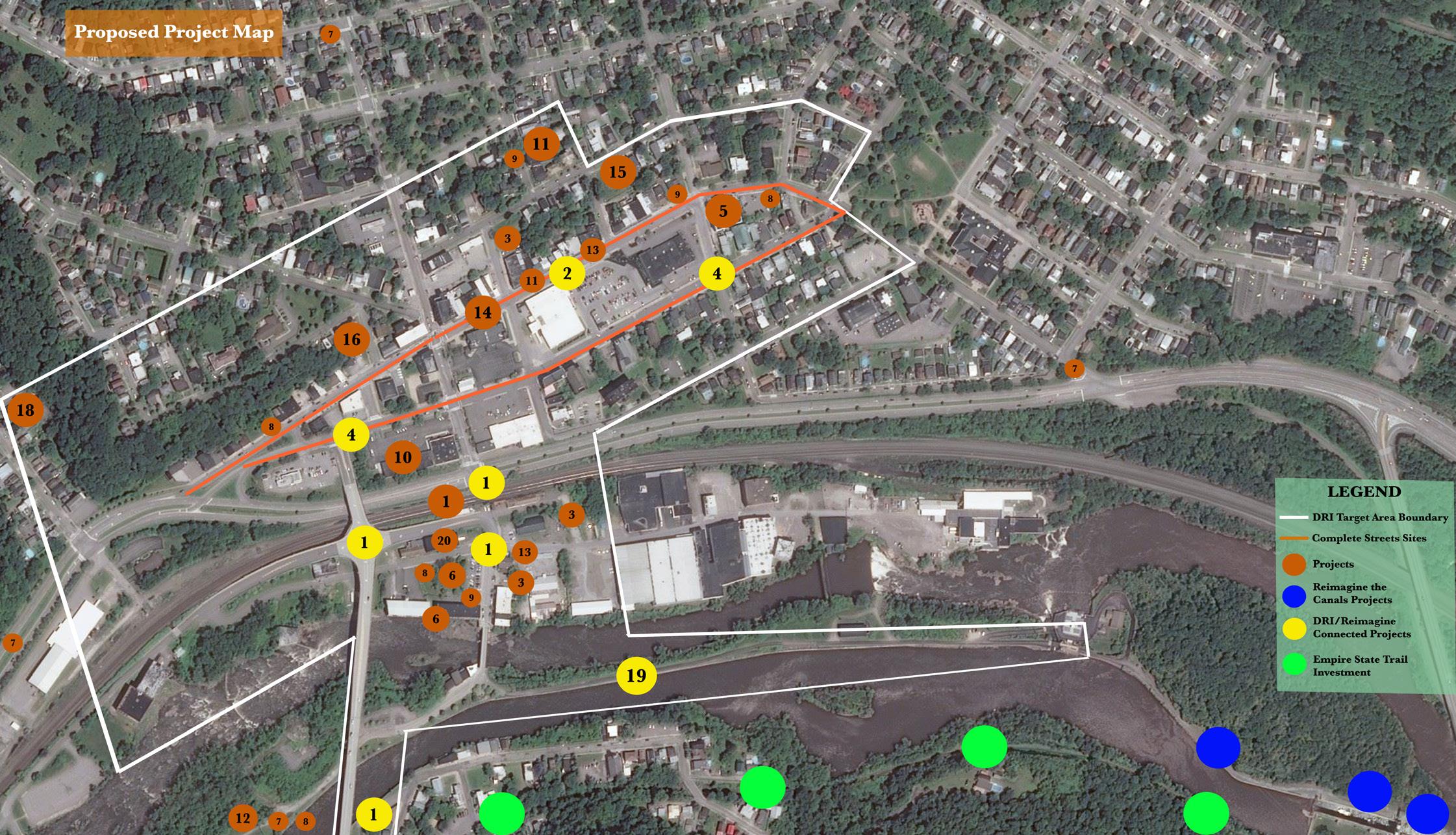

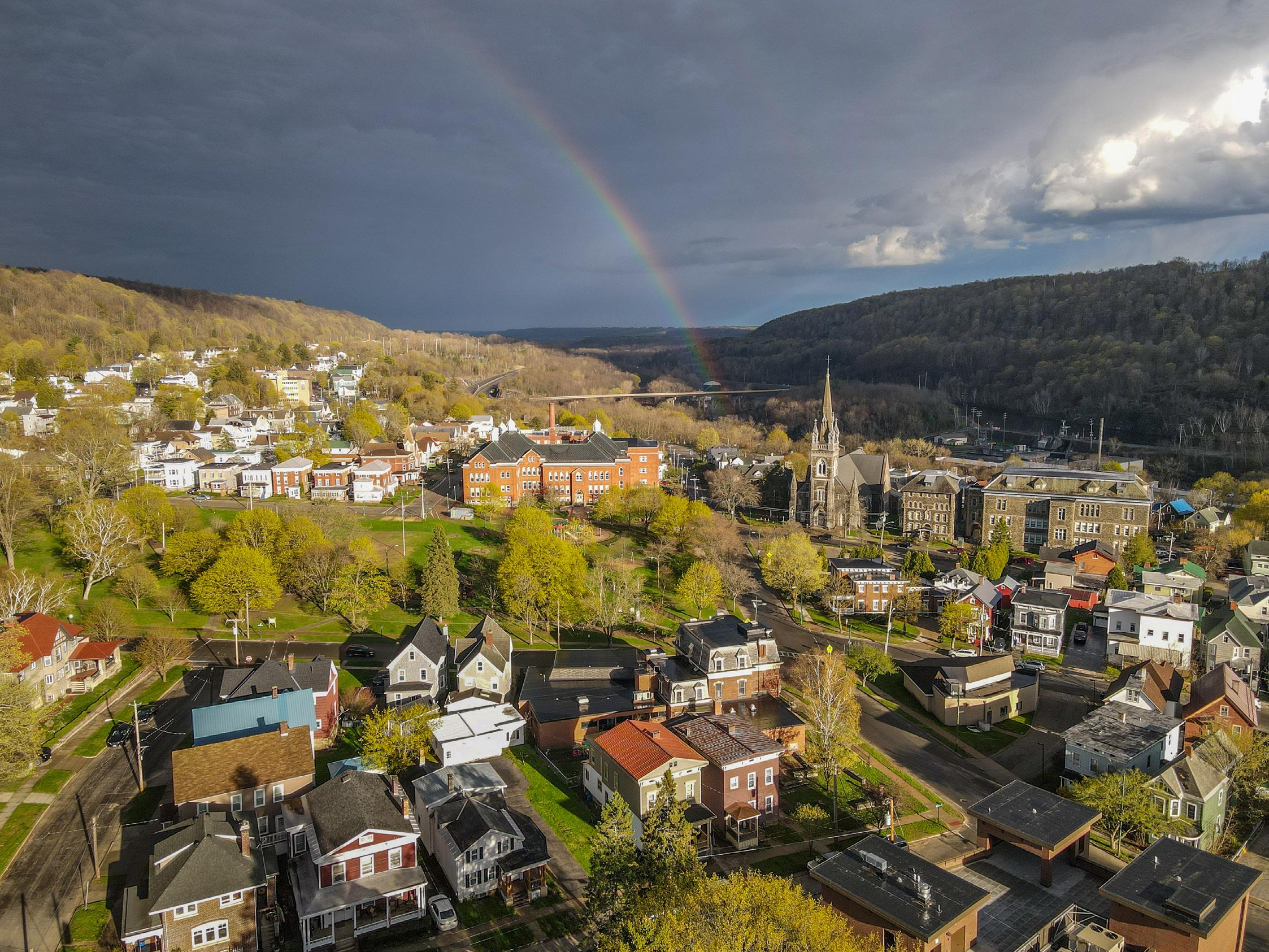
Past Investment, Future Investment Potential
Describe how this DRI area will be able to capitalize on prior private and public investment and catalyze future investments in the neighborhood and its surrounding areas. Describe recent planning efforts that support public and private investment in the proposed DRI area.
Recent Planning Efforts:
The following plans support the Downtown Waterfront District public and private investments:
• NYS Brownfield Opportunity Program Revitalization Report (2020)
• John Zogby Strategies — Little Falls Rising: A Good Story, A New Narrative (2019) • Little Falls Local Waterfront Revitalization Program (2010)
• Erie Canalway Preservation and Management Plan (2008)
• SHoP/Buro Happold Little Falls Connectivity Study (2021)
• Little Falls Railway Station Feasibility Study (2021)

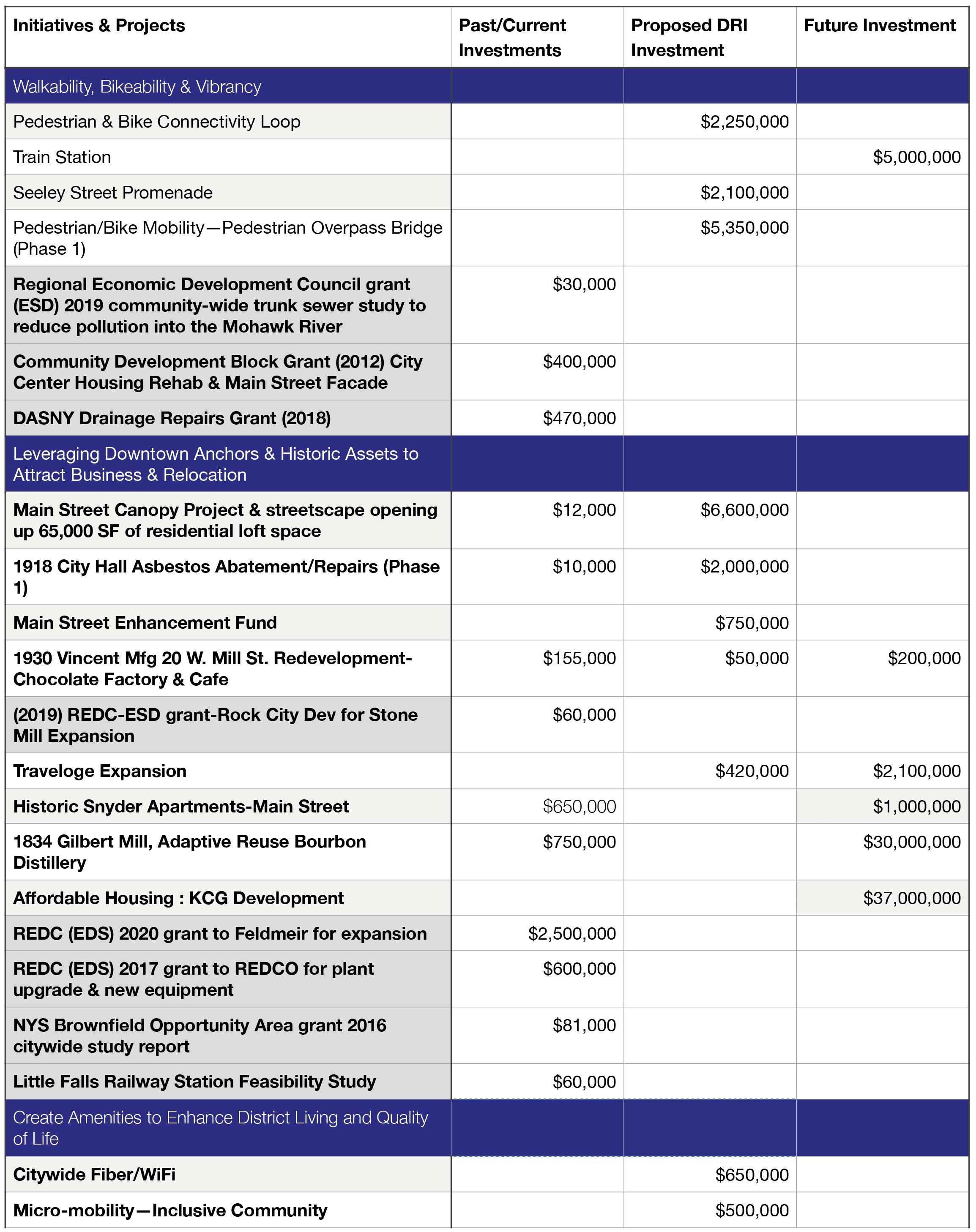


Recent, Impending Job Growth
The existing businesses and industries in Little Falls and Herkimer County are important to understanding the existing economic strengths and assets, as well as to help identify future opportunities for industrial reuse and redevelopment. The Little Falls area, as defined by Zip Code 13365 that includes areas outside of the City, has a number of “industrial” businesses including thirteen (13) manufacturing, four (4) wholesale trade, twelve (12) construction, three (3) transportation and warehousing, and two (2) utilities companies. The table below provides a profile of the industries and businesses in the Little Falls area.
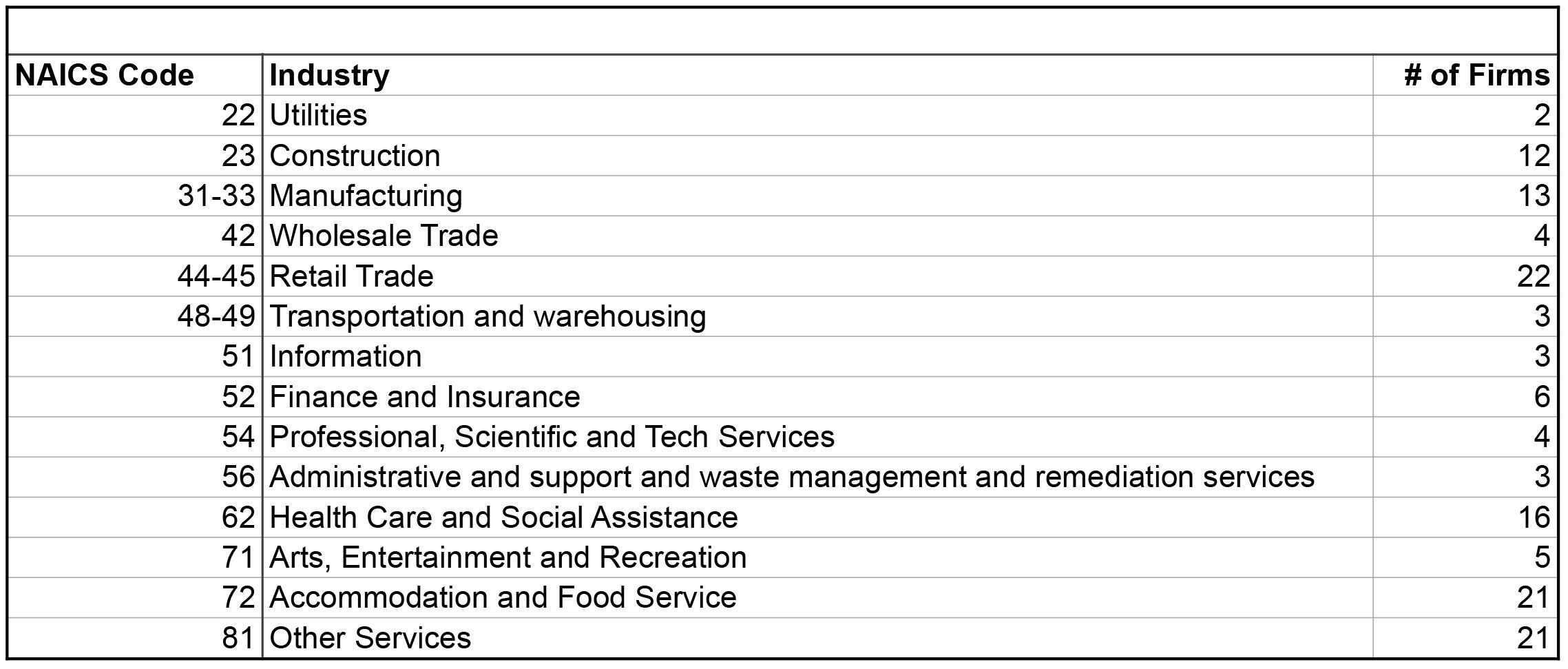
Source: U.S. Census Bureau, 2016 Zip Code Business Patterns
The City’s major industrial employer is Feldmeier Equipment, which is a manufacturer of stainlesssteel tanks, vessels, skidded systems, silos and tubular heat exchangers. The company employs approximately 150 employees and recently invested millions of dollars in a new facility in the Riverside Industrial Park. There is also a notable concentration of wood products-related economic activity in Little Falls including Twin Rivers Paper Company that employs approximately 60 workers and Ideal Wood Products that employs another 50.
Other manufacturing activity in the City includes Vincent Manufacturing, also located in the district, which processes cotton material for furniture and bedding. The City had been home to REDCO Foods until 2018 when it closed its Salada brand tea-making plants within the BOA on Hansen Island. This facility was recently purchased by Luminati Aerospace to relocate its carbon-fiber helicopter blade business to Little Falls, which could add approximately 30 jobs over the next few years.
Industry Opportunities
Industry growth trends were examined to identify opportunities that may be aligned with available industrial spaces in Little Falls. The data analysis examined trends at the county-level due to data

Feldmeier Equipment facility along the Industrial Park in Little Falls.
limitations at the local level and the importance of considering broader regional economic trends. Based on the most recent data available, manufacturing has seen strong growth adding over 450 jobs in the county from 2012 through 2016 – an increase of 17%. Wholesaling has also seen growth, but it overall is a small sector relative to manufacturing. Similarly, transportation and warehousing has shown growth but provides only 249 jobs in the county as of 2016.
Within the manufacturing sector, fabricated metal product manufacturing is the most significant, providing over 2,100 jobs (67% of all manufacturing jobs in Herkimer County). Businesses in this industry transform metal into intermediate or end products (other than things like machinery, computers and electronics). It includes activities such as stamping, forging, and forming metal into metal products, such as cutlery, hand tools, tanks, bolts, nuts, and screws.
Much of the wholesaling activity is linked to this manufacturing sector, including machinery, equipment and supplies merchant wholesalers and industrial machinery and equipment merchant wholesalers. Food manufacturing is another significant subsector accounting for nearly 400 jobs (nearly 13% of all manufacturing jobs).

The chart below shows a high-level overview of industry growth trends from 2012 through 2016 for Herkimer County.

Little Falls Business Investment, Relocations & Job Growth
Recent Commercial Real Estate Investments in Target Area: ($24.35 million)
• Rock City Centre Building (2020) $3.6m estimated • Rock City Development, LLC (2017-2020) $3.1 million • Daniel Preston Investments (2017-2021) $4.2 million
30 New Business Launches in Target Area
5 new businesses in 2020 8 new businesses in 2019 6 new businesses in 2018 2 new businesses in 2017 4 new businesses in 2016 2 new businesses in 2015 4 new businesses in 2014
• Copper Moose Ale House (2021 - new ownership) • Italian Feast (2021 - new ownership) • Ironrock Brewing Company (2019) • Canal Side Inn (2019 - reopened new ownership) • Stone Mill Inn —9 room Inn (2019 - reopened new ownership) • Mohawk Microgreens (2020) • MyLitteFalls (2018) • Funtech Providers (2019) • Ruggiero’s Tap & Tavern (2018) • Little place on Main (2014) • John Healy Agency (2016) • Coco’s Bazaar(2017) • Body Siense (2018) • Kress Physical Therapy (2018) • A&W Greenhouse and Gardens (2020) • Ace Hardware (2017) • Fitness Farmacy (2015) • PrimaDonna’s Boutique (2016) • ArtDoor Gallery (2019) • Cafe @ the Stone Mill (2019) • Northstar Recycling (2014) • Rock City Development, LLC (2019) • Showcase Antiques of CNY(2015) • UPS Store (2020) • Mangia McCrina (2020) • Rock City Barbershop (2019) • Bonita’s Sandwich Chef (2018) • Towpath VisionCare (2014) • Greater Mohawk Valley Land Bank (2018) • Twin Rivers (2016) • Creative Outpost, Inc. (2021)
Jobs— New Business/ Relocations: (117 jobs)
• Luminati Aerospace (2019) projecting 10 new jobs by 2022 (Relocated from Long Island) • Northstar Recycling (2015 with 4 employees, grown to 45 employees in 2020) 49 new jobs projected 2022 (Corporate headquarters MA) • Cocoa Prieto Chocolate Factory/Cafe (coming 2021) 5 new jobs projected (relocated from Brooklyn) • Daneli Partners (2018) 4 new jobs (MA)

• TILTX (2019) 2 jobs (relocated from TX) • Fun Tech (2019) 2 jobs (relocated from NYC) • Mohawk Hospital Equipment/Mohawk Healthcare 100,000 sq. ft. Facility in Industrial Park (2019) 27 new jobs (relocated from Utica) • Travel Lodge Expansion (2022) 4 new jobs • Youth & Family Center Childcare Expansion (2022) 4 new jobs • Ironrock Brewing Company (2021) 10 new jobs
Future Investment
Little Falls is Primed for Growth over the next Decade with Future Projects
Our City’s DRI vision is only half of the story. All the things that make Little Falls a great place to live, work and play— are the same things that make it a great investment opportunity for developers.
Today, there are over $76.8 million in future development projects beginning or underway that exemplify the City’s new wave of business vitality, social improvement and cultural renewal. These projects cover investments in real estate, placemaking, waterfront development, historic renovation, downtown redevelopment and residential development.
Little Falls offers developers several advantages including a much lower cost of entry making it possible to diversify and invest in multiple properties for the price of one urban luxury property. It’s central location, businessfriendly environment, and the fact that portions of it are situated within an Opportunity Zone add to its appeal. ZAIDA - A KCG Companies development
Zaida is KCG Development’s proposed new construction, multifamily community situated off Valley Brook Drive in Little Falls, NY. This $37M investment will offer a mix of 150 one-, two-, and three-bedroom apartment homes with in-unit and community amenities catering to area professionals and young families earning between 60-120% of the Area Median Income.
Little Falls, NY has special character and offers quality of life experiences and amenities unsurpassed by anywhere else in the Mohawk Valley. Most of the City’s housing stock is older, with 75% of the homes built prior to 1939. Existing multifamily housing is primarily characterized by aging single family home conversions and small multi-unit buildings. Renters in the region seeking high quality, multifamily housing with amenities look beyond Little Falls to Utica and Rome.
Zaida will be the first of its kind in Little Falls – a Class A rental community with in-unit and community amenities tailored toward working professionals and young families seeking high quality, affordable and attractive housing in Little Falls. In concert with other local and regional economic development efforts, Zaida will help to establish Little Falls as a vibrant destination for young families and professionals to settle down.
Established in 2015, KCG is a mixed-use and multifamily housing developer founded on the principle that positive social impact and profitable development are not mutually exclusive. Never taking a “one-size-fits-all” approach, we take pride in our commitment to aligning our vision with that of local stakeholders. Through this customization, we build sustainable communities that represent long-term value and opportunity for residents.
KCG’s approach to development and strong values are reinforced by the experience of its team members. Throughout their careers, KCG principals have collectively financed, developed, or built more than $3 billion of multifamily rental housing. This combined expertise allows KCG
to craft unique, market-responsive development solutions and effectively leverage a wide range of financing sources.
In 2020, KCG was ranked 26th on Affordable Housing Finance’s list of top Multifamily Developers. This success is a testament to their multi-disciplinary development approach and KCG’s strong partnerships with housing agencies, financial partners, local stakeholders, and their residents. KCG Development is the developer and owner of The Lofts at Globe Mill in Utica, New York and AP Lofts in Buffalo, New York.
Images of select KCG Development’s communities.

Re-activation of the riverfront with a bourbon distillery at the Gilbert Mill
The concept, put forth by Daniel Preston, is to re-activate the Hansen Island, Gilbert Mill area along the Mohawk River with a new type of recession proof green industry - Bourbon distilling.
By comparison, Ole Smoky’s three East Tennessee distilleries welcomed 4.1 million visitors in 2018. The Ole Smoky Moonshine Holler in Gatlinburg welcomed over 2 million visitors; Gatlinburg’s Ole Smoky Whiskey Barrelhouse welcomed over 900,000; and the company’s Pigeon Forge distillery, The Barn, welcomed 1.1 million.
By comparison, Ole Smoky entertains more than twice as many guests as all of Scotland’s distilleries combined. According to publicly available data, Scotland’s 74 whiskey distilleries saw 1.9 million attendees in 2017.

Each Ole Smoky distillery location includes working stills and fermentation tanks and an expansive visitor experience, including self-guided tours, tastings, live music and large retail shops featuring Ole Smoky moonshine, whiskey, apparel, accessories and food.
Preston has purchased the property, and hired architects to flesh out the concept.

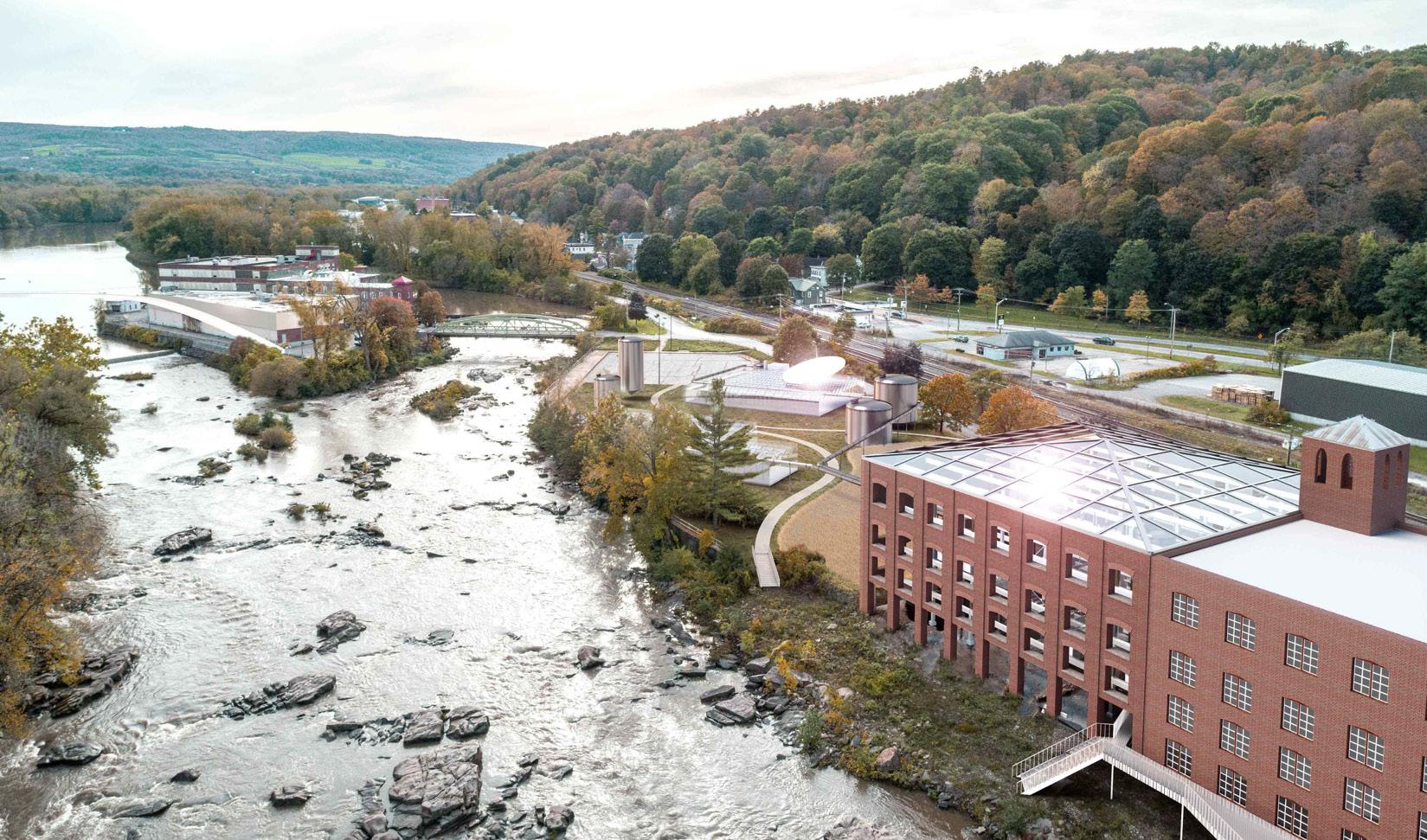
An aerial and interior view of the proposed Gilbert Mill conversion to a bourbon distillery and tourist destination.
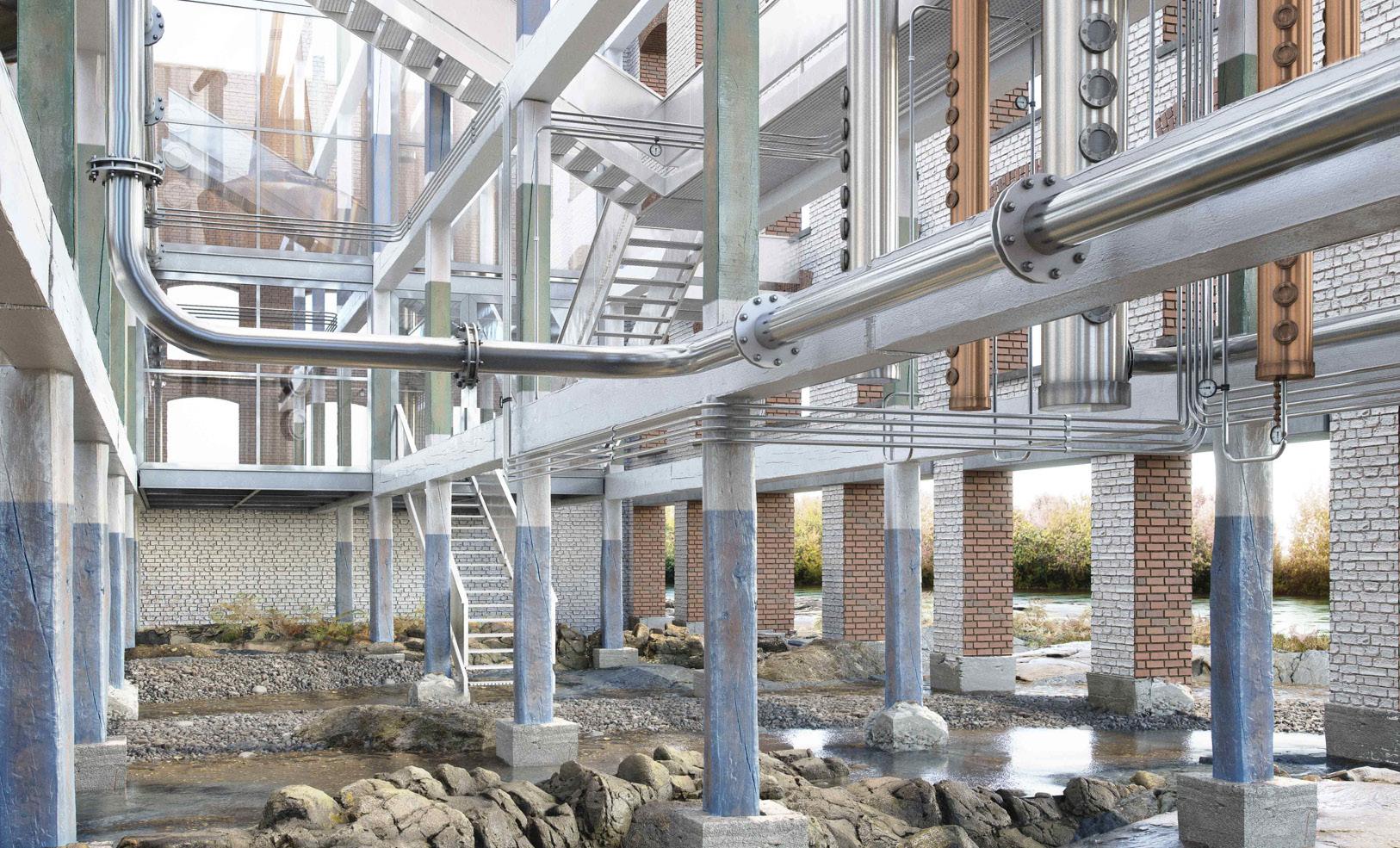
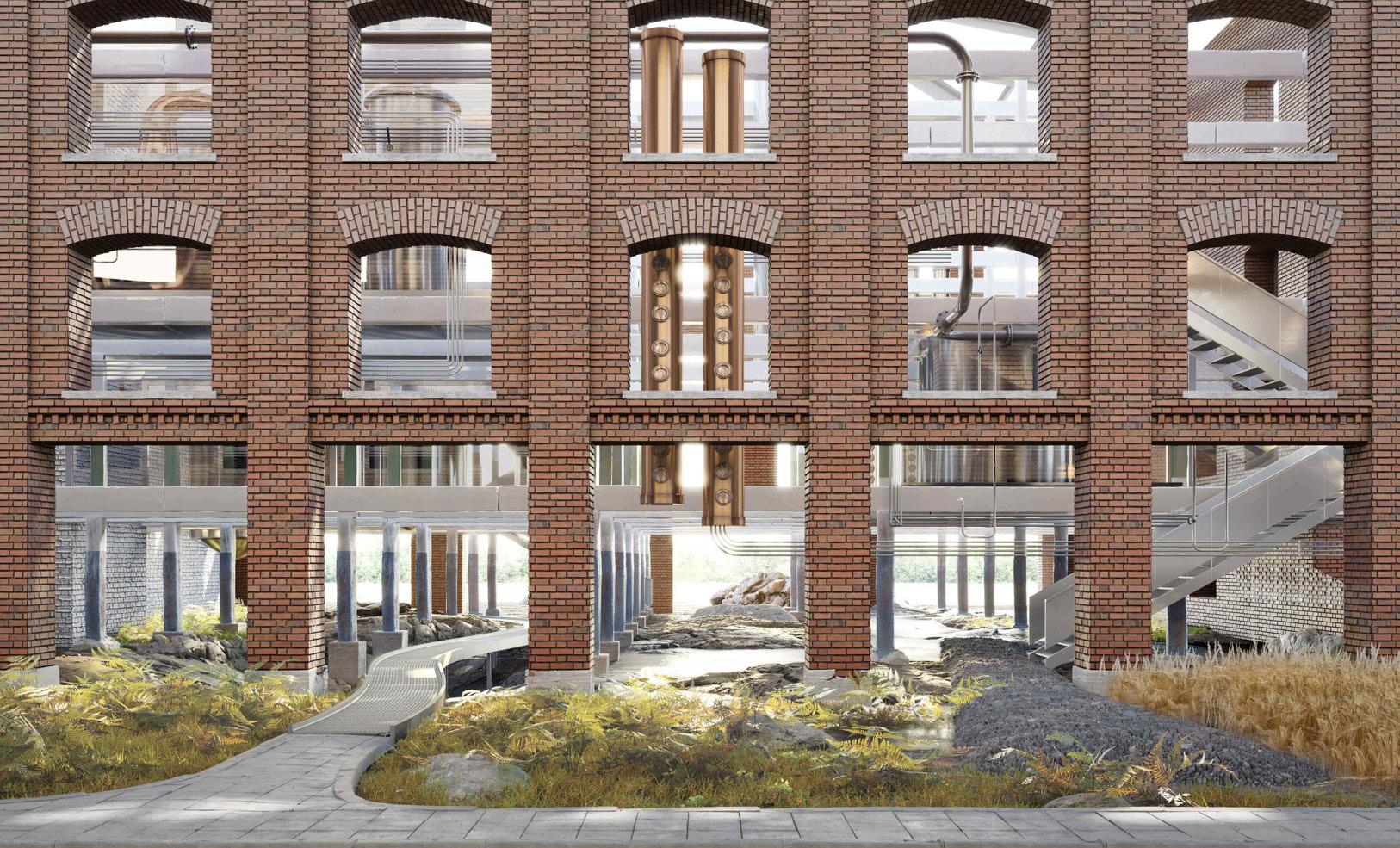
A roadside view looking south at the proposed distillery in the old Gilbert Mill building.
Passenger rail is an essential element of America’s surface transportation system. The main provider of intercity passenger rail service is the National Railroad Passenger Corporation, also known as Amtrak. Amtrak serves more than 500 destinations in 46 states.
Beginning in the fall of 2021, a consulting team was engaged to explore the feasibility of siting a new railway station and resuming passenger rail service to the City of Little Falls, New York. This initial study, funded through private foundation grants, will examine the history of rail transportation in the region, and seek to identify the infrastructure, alignment, connections, ridership potential, and other related factors necessary to re-establish service to the area.
In addition to analyzing the viability of a Little Falls station, the City’s central location in Upstate New York would also catalyze future service expansions in surrounding Mohawk Valley communities.
Beyond the infrastructure, engineering, and technical aspects, the project will seek to develop relationships between and among government approval agencies and business and opinion leaders to establish the need and identify the features, and benefits of the Little Falls Railway Station and service. The feasibility review will identify and present fact-based information about the tourism, quality of life, and economic benefits resuming rail service can provide to the communities it will serve.
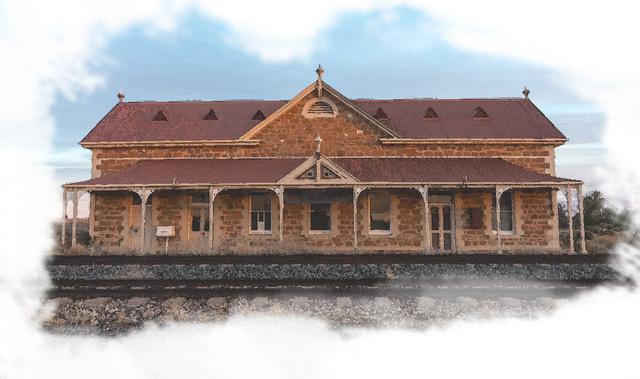

Lock View Park
Celebrating Iconic Infrastructure Destinations Plans are underway to determine signage, additional parking needs, bike parking area, and restroom locations.
Additional plans are to provide a small boat/ kayak launch area, pedestrian path, lighting, seating, and add a “Lock Climbing” wall, playbround and outdoor movie area.
A study initiated by NYPA, ShoP and Buro Happold, provided insight into how the City could celebrate different iconic infrastructure destinations within the City, such as Lock 17.
Celebrating iconic infrastructure destinations / Creating a new park at Lock 17
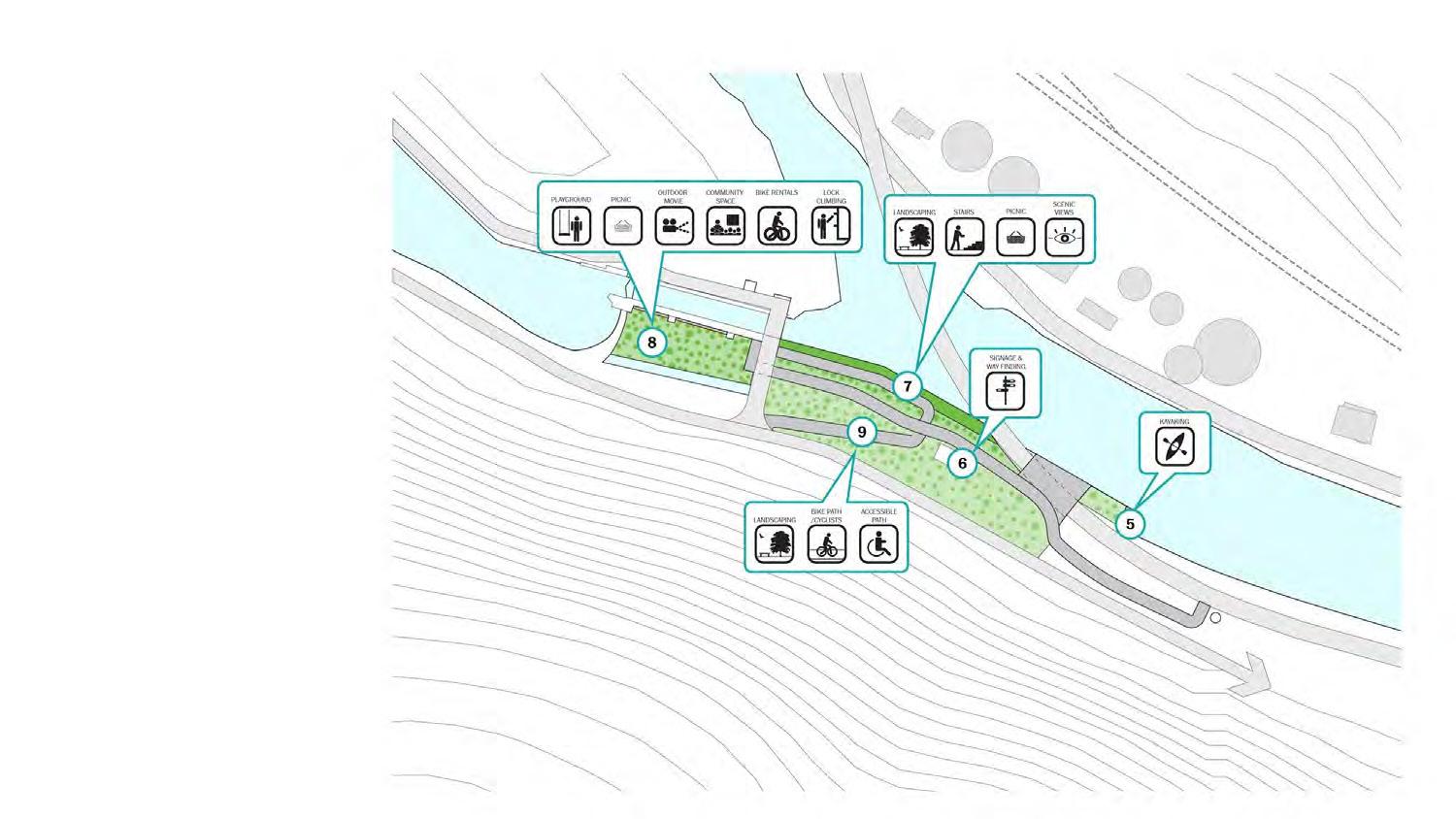
5. Provide small boat/ kayak launch area east of Lock 17 for convenient route to Herkimer Home.
6. Provide signage and wayfinding to destinations and scenic views.
7. Provide pedestrian path, landscaping, lighting, seating for “Lock View Park”, an amenity for viewing Lock 17.
8. Remediate Side Pool area. New landscaping and outdoor furniture. Add ‘Lock Climbing’ wall, playground, outdoor movie area,
9. Renovate existing ADA ramp and provide landscaping, lighting and a bicycle channel at the stair.
100 250 500
Loomis Island Development and Pedestrian Crossing - New Opportunities to Enhance Recreation and Tourism Along the Erie Canal
The proposed concept would reopen the west end of Loomis Island as a nature preserve destination and commmunity space for public use. It would provide waterfront for access to the scenic river views, outdoor furniture, a sculpture park and lighting.
The existing building structure on Loomis Island would be renovated to provide restrooms, picnic areas, bike rentals and boat rental/storage. Gate, providing a new infrastructure tourism destination. A new pedestrian crossing to Loomis Island would provide direct access to the South Side and the Erie Canalway Trail, linking in several other DRI projects.
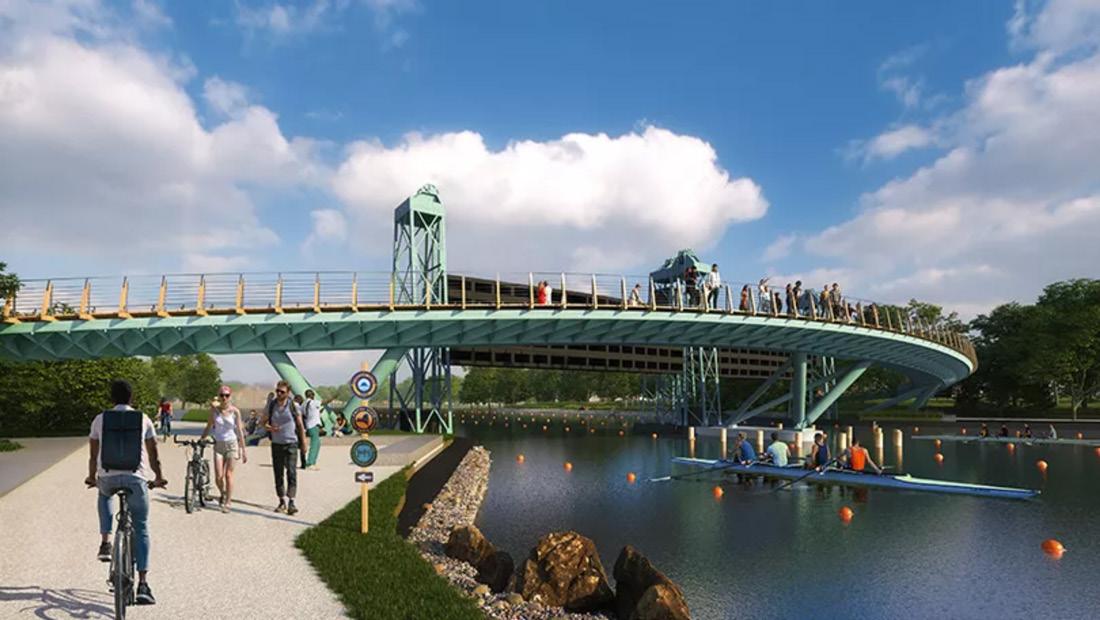
New opportunities to enhance recreation and tourism along the Erie Canal / Moss and Loomis Island Assets
Proposed improvements
6. Reopen west end of Loomis Island as a nature reserve destination and community space for public use. Add secondary walking paths with wayfinding signage to scenic destinations. 7. Landscape waterfront for access to scenic river views. Add outdoor furniture and lighting. 8. Renovate existing building structure on Loomis Island to support tourism. Provide restrooms, picnic areas, bike rentals and boat rental/storage. 9. Provide small boat launch location on Loomis Island, option to provide boat rentals at visitor center.
Waterfront access to scenic views Landscaped nature reserve ‘Loomis Park’
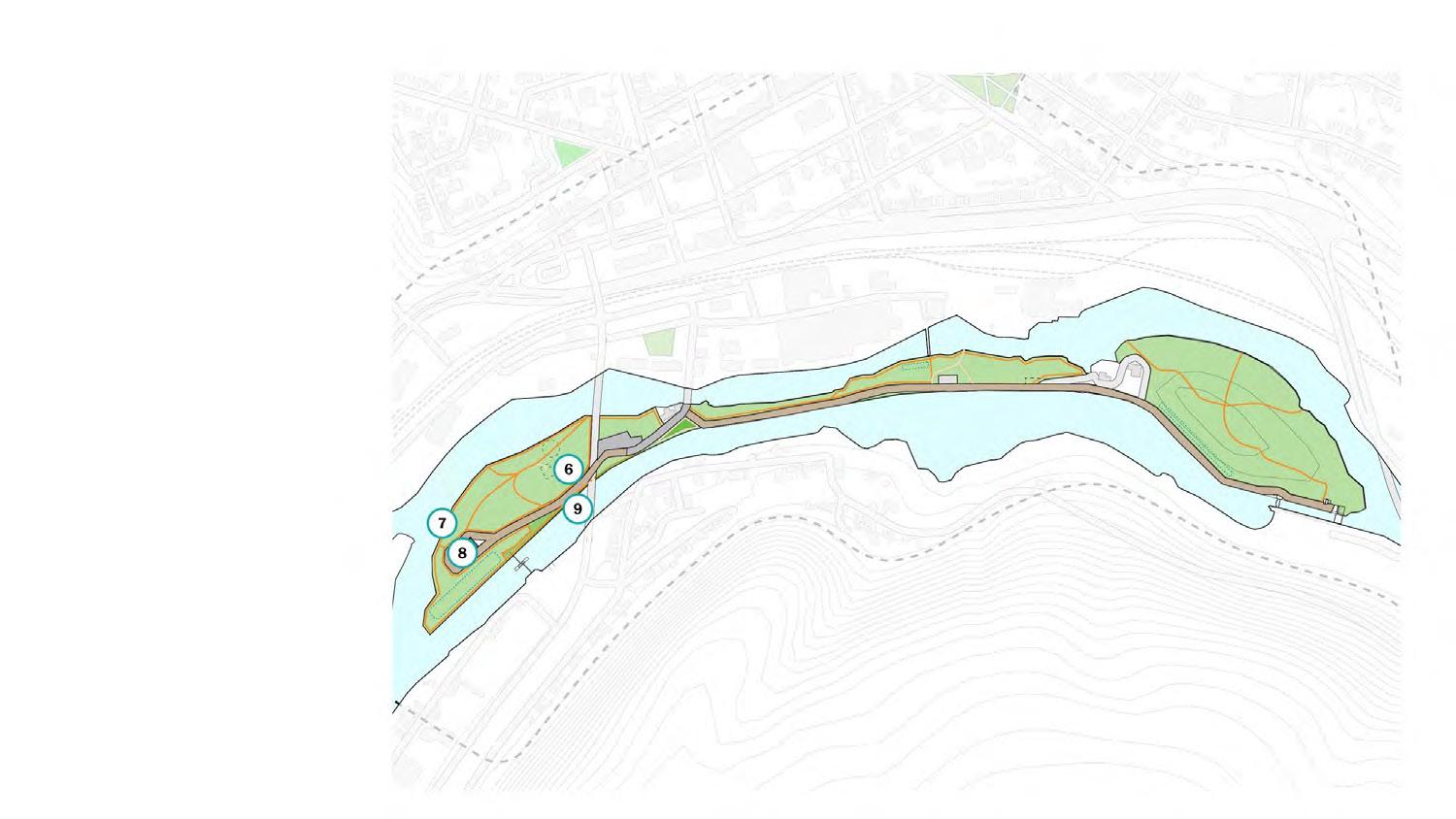
Renovated Boathouse Rental and Cafe Boat Launch at the Canal
200 500 1000
Excerpts from the SHoP Buro Happold Reimagine Little Falls Connectivity Study
New opportunities to enhance recreation and tourism along the Erie Canal / Moss and Loomis Island Assets
Proposed improvements
10. Provide feature lighting for Guard Gate as a new infrastructure tourism destination. 11. Create new connection to Loomis Island for direct access to South Side and the Erie Trail. 12. Renovate existing bridge as pedestrian path, providing additional viewing platform to water and connection to Canal Place and downtown. 13. Redevelop empty industrial buildings at Canal Place and along Mill St to create new retail corridor as extension of Canal Place.
Light iconic historic structure at Guard Gate Develop empty properties around Canal Place Restored and light historic bridge with landscaping
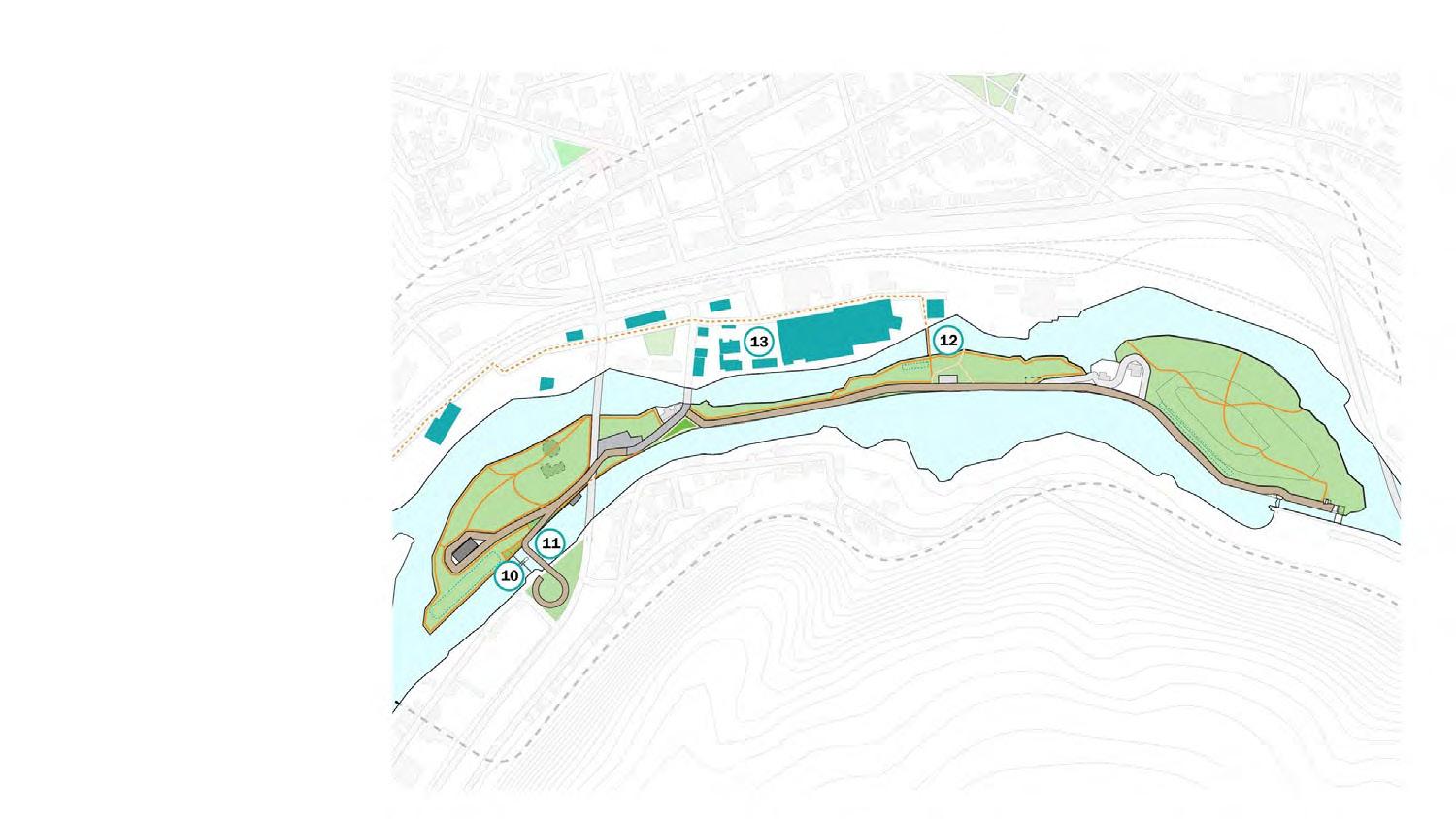
New Loomis crossing over the canal to EST
200 500 1000


Attractiveness of the Physical Environment
Identify the properties or characteristics that the DRI area possesses that contribute, or could contribute if enhanced, to the attractiveness and livability of the downtown for a diverse population of varying ages, income, gender identity, ability, mobility, and cultural background. Consider, for example, the presence of developable mixed-use spaces, varied housing types at different levels of affordability, walkability and bikeability, healthy and affordable food markets, and public parks and gathering spaces. Little Falls is a welcoming community with a geographically picturesque location on a slope of a narrow and rocky defile, through which the Mohawk River falls 45 feet in less than a mile, forming a number of breathtaking cascades. Tucked along the sides of a steep gorge carved by the Mohawk River running adjacent to the manmade Erie Canal, Little Falls became

the port-of-call for shipping grain to Albany and later a leader in the knitting, paper, tea, metals, and cheese industries. The City quickly became known as an industrial hub attracting an influx of European immigrants in the early 1920s seeking jobs in the factories and mills along the waterfront. This migration propelled the population to 13,029 people, influencing the ornate architecture, culture, food, abundant parks, and entrepreneurial spirit that remains throughout the Downtown Waterfront District.
Examples of the City’s rich industrial age can be seen today lining the streets of the target area, many of which are listed on the State and National Historic Registers with period designs including: Italianate, Beaux-Arts, and Colonial Revival. These, often below market, historic properties, many of which are in need of rehabilitation, offer abundant investment opportunities for affordable residential use, adaptable re-use of factories/mills, and increased mixed-use development throughout the downtown area.
Reviving and preserving the historic assets and rich cultural fabric that has supported the city during its industrial period will support its renewal as a walkable downtown waterfront community with a focus on quality-of-life amenities driven by a strategic design that is optimized for human use.
Today, Little Falls is on the cusp of a new migration for its idyllic lifestyle; the perfect place to raise a family, retire, or start a new business. With the surge of employees telecommuting and the short 30-45 minute commute to the job markets of Utica/Rome, choosing a home town is not necessarily dictated by where you work, but more importantly where you want to live. People who have recently relocated their businesses and families to the community cite “improved quality of life” as their primary reason for
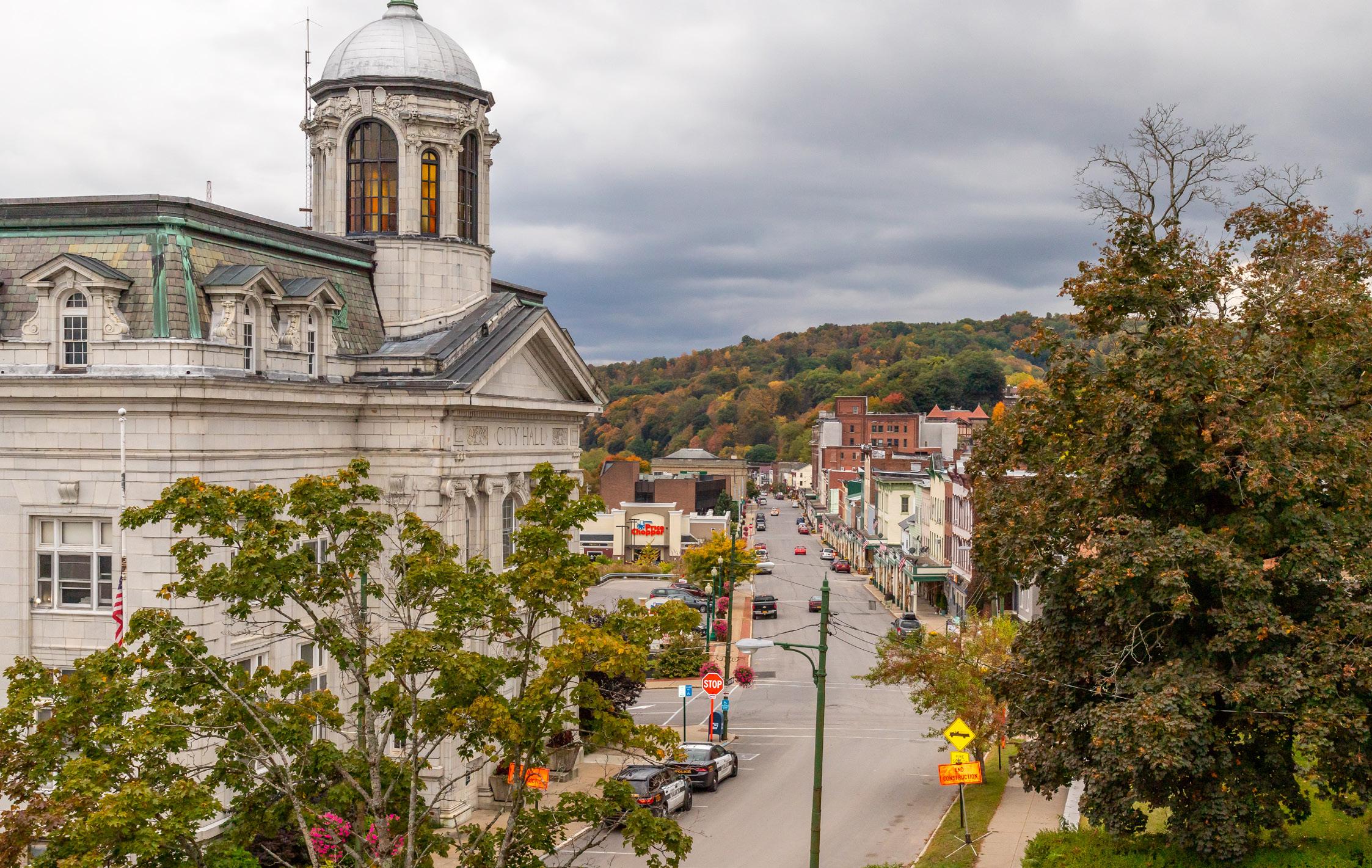

choosing Little Falls and its access to waterfront recreational activities, rock climbing, bicycling, shopping, antiquing, festivals, farmers markets, great dining and quality of life amenities like a hospital, movie theater, bakery, and a butcher shop, things rarely seen in a small city.
By leveraging the value of its geographic,
cultural and architectural assets, the City is able to create the conditions necessary to actualize its vision as the most desirable residential community in the region…attracting a diverse population supported with commercial and residential development, quality-of-life amenities, and a tax base that provides sustainable prosperity for future generations.
Treasuring Our Heritage
In recent years, Little Falls has taken concrete steps to recognize and preserve its rich historical and architectural heritage. An emergent concern for historic preservation is best exemplified by the 2012 creation of the Little Falls National Historic District, which includes 347 buildings in Little Falls, starting on Main Street, and sprawling across the neighborhoods that lie to the north, east and west. Previously, in 2008, several of the mill buildings and row houses in what is now known as Canal Place became the basis of the South Ann Street-Mill Street Historic District. Little Falls must now stand out as a place where dynamic growth can be balanced with the retention of its unique community character.
Development of Varied Housing Stock
As the City returns to demographic growth, it is necessary to solicit and support the development of varied housing types at different levels of affordability. Little Falls has been fortunate to see increased investment in its historical building inventory in recent years, with increased public and private funding availability prompting many investors to embark on adaptive reuse projects in the Downtown Waterfront District.
Development to date has been scattered, focusing on buildings likely to provide a timely return on investment. Many larger buildings are either undeveloped or underdeveloped. Potential developers interested in these larger structures must overcome challenges such as the sheer size and scope of rehabilitation, and accessibility issues to upper floors.
With a nearly one-third vacancy rate and worn out storefronts, the upper floors consist of obsolete apartments and dusty storage space.

The DRI Canopy project that incorporates fire escapes into the design would improve the safety and accessibility to these upper levels. This project, alone, has the ability to open up approximately 65,000 sq. ft. of revenue-
producing residential space to property owners and significantly add to the City’s available housing stock.
Several once-ornate neighborhoods within the downtown district contain boarded up houses and dilapidated single-family homes. Long-time residents cannot afford needed repairs, and downtown landlords are unable or unwilling to renovate apartments or fix up storefronts to attract new retail tenants and customers. The Main Street Enhancement Fund and the Historic District Housing Fund DRI projects both address these challenges with low-interest funds and grants for storefront facades, painting, lighting and historic home structural repairs to facilitate rehabilitation and stabilize living conditions.
To attract a more diverse residential population living in the downtown district, Little Falls needs large scale as well as small scale housing options at market rates that accommodate all incomes and abilities.

“ I envision the Downtown Waterfront District will...
DRI Community Survey Input ...

Enhanced Walkability & Bikeability Vision
The City has a long history of walkability and currently enjoys a 71% Walkability Score throughout the target area. Most errands can be accomplished on foot. However, when it comes to bikeability, the City is lacking in minimal bike infrastructure with a Bike Score of 23 based on bike lane infrastructure, road connectivity and destinations.
The City’s multimodal transportation and Complete Streets initiative enables varied kinds of transportation, including pedestrians, bicycles, e-bikes and e-scooters. Main Street, Canal Place and the Harbor will be multimodal streets that balance the needs of all modes of transportation, with environmental sustainability and infrastructure upgrades that include: the DRI Pedestrian & Bike Connectivity Loop with tunnel underpass enhancements, DRI Pedestrian Overpass Bridge project, the DRI Seeley Street Promenade project, and a future NYPA proposed Skybridge connecting Lock 17 to the Empire State Bike Trail.
The City’s e-mobility initiative includes bike rental/repair stations with easy connections to destinations like the Harbor for kayak rentals, Moss Island rock climbing, historic Lock 17, the 750-mile Empire State Trail, and the Erie Canalway Trail. Healthy & Affordable Food Markets
Unlike many small cities, Little Falls has a modest variety of healthy and affordable food markets including the recently built full-service Price Chopper, Community Co-op health food store, the Food Pantry, two Farmer’s Markets, a new hydroponic Microgreens store, and a farmto-table fine dining option.
The City also has 19 restaurants and eateries representing a variety of cultural cuisines including American, French, Italian and Chinese as well as a popular bar and grill, breakfast and lunch cafes, a diner with homemade food using garden-grown vegetables, coffee shops, a bakery and a butcher shop.
The close connection to agriculture surrounding the City offers numerous advantages including: fresh produce stands, home delivered eggs, and milk and cheeses. Once known as the Cheese Capital of the US from 1864 to 1870, Little Falls was the largest cheese market in the world. This heritage is celebrated every year in October at the city’s cheese festival drawing crowds of 6,000 people or more from around the region to sample cheeses made from local farms. Public Parks & Gathering Spaces
The City of Little Falls has an extensive network of parks, many within a quarter-mile walk of the target area including historic Ward, Burke and Moreland Parks; Veteran’s Memorial Park, home of the Diamond Dawgs collegiate baseball team, baseball fields, softball fields, a basketball court, and a tennis court; a 9-hole municipal golf course; Canal Harbor, Rotary Park, Steriznar Park (within the target area) at Canal Place, and Moss Island recreational area. There are also seasonal gathering spaces including the ice skating rink at Monroe Street Park and the municipal swimming pool on the northwest side of the City.

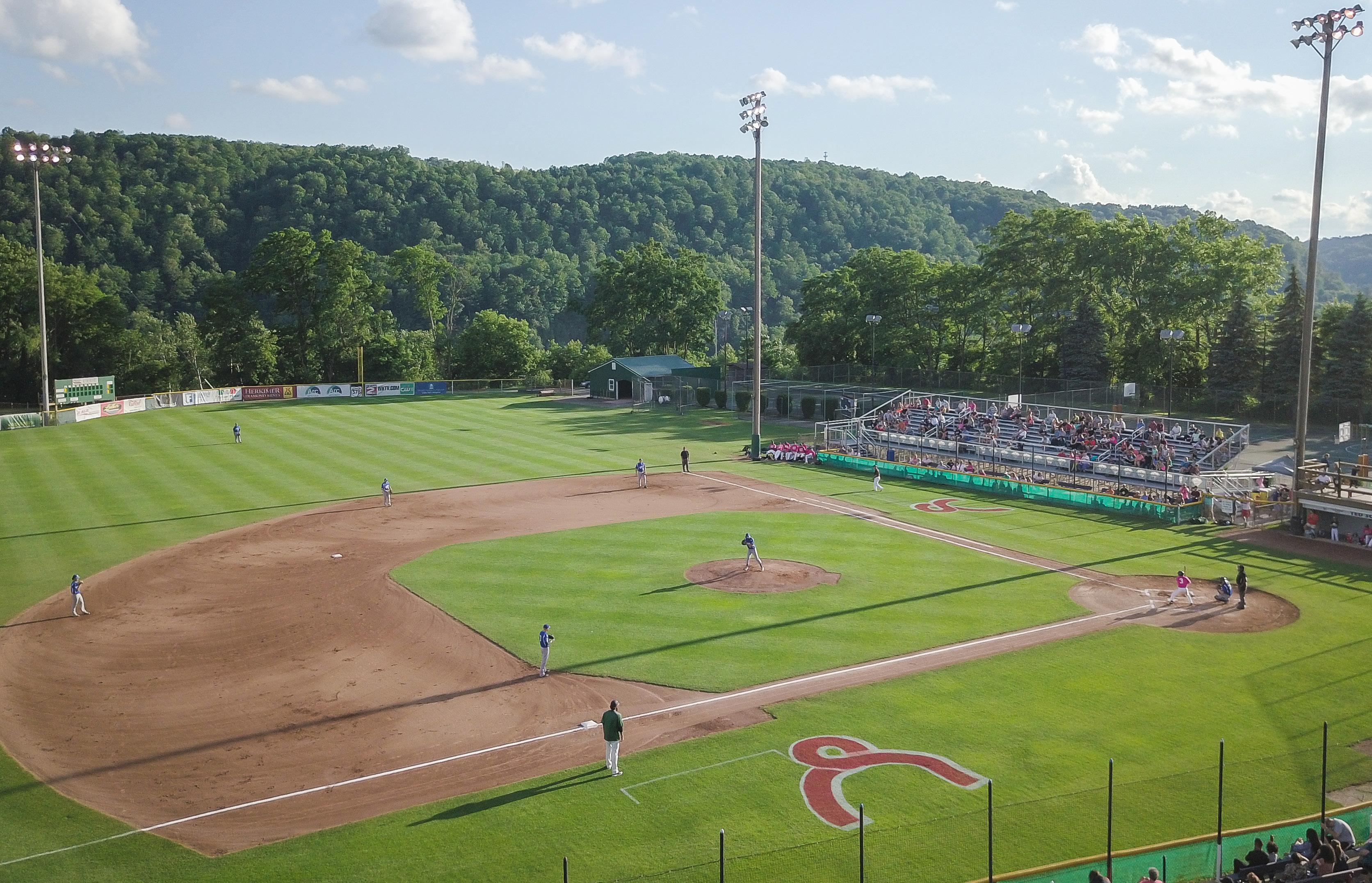
An aerial view of Veterans Memorial Park with the Diamond Dawgs collegiate baseball team plays
The City also sponsors a free seven-week, supervised recreation program that uses local parks and playgrounds combined with weekly special field trips.
There is also a Little Falls Youth and Family Center facility with basketball court, indoor swimming pool, workout facility and childcare services a block from Main Street with a DRI capital project to upgrade the facility as well as the Main Street Senior Community Center.
The City is working to map streets and trails supported with DRI projects for Wayfinding signage and eMobility stations that would allow park users to reach their destinations using multiple modes of travel, in an effort to eliminate barriers to access and improve community health. People are more likely to use parks for exercise if they are attractive, safe, and desirable places to spend time.
Providing routes for Downtown Waterfront District residents to safely walk and bicycle to quality parks will further enhance the City’s ability to attract visitors and new residents.
Quality of Life Policies
Articulate the policies in place that increase the livability and quality of life of the downtown. Examples include the use of local land banks, modern zoning codes, comprehensive plans, complete streets plan, transit-oriented development, nondiscrimination laws, age-friendly policies, and a downtown management structure. If policies that support livability and quality of life in downtown are not currently in place, describe near-term efforts by the municipality to create and implement such policies.

Local Land Banks
The Greater Mohawk Valley Land Bank (GMVLB) was created by NYS in 2011 and is the only land bank in the Mohawk Valley region. GMVLB received $1.642 million in its first year to help promote economic growth in the six-county region by mobilizing empowered citizens, governments, and other community resources, including nonprofits, to fight blight and to create vibrant, sustainable communities, neighborhoods, and properties. The City of Little Falls considers the GMVLB to be another tool in its DRI revitalization toolbox. Modern Zoning Codes
Updated in 2011 to include a Waterfront District, the City’s zoning generally mirrors current land use patterns of the city. This amendment to the City’s Zoning Regulations was approved by the Common Council to permit a mixture of residential, commercial, light industrial uses, and waterfront related uses subject to Planning Board approval that discourages and prevents the siting of inappropriate, non-water related uses within the district. Site plan review provisions are also incorporated in the district.
For purposes of the DRI, the City is satisfied with its zoning ordinance in terms of promoting redevelopment opportunities within the target area. The City would like to encourage in-fill construction of single-family homes along West Main Street, which may include reuse of some vacant parcels in current industrial and commercial areas. Industrial zoning for Mill Street, Loomis, and Hansen Island may need to be reviewed for large mixed-use residential, marinas and resort projects where zones may need to be customized to fit the adaptive reuse of vacant factories and mills. Comprehensive Plan
The City of Little Falls Comprehensive Plan (2018) was designed to provide a framework of policy direction and recommendations to guide the City and its partners in the formulation of development strategies, economic incentives, and land use controls that collectively foster development supportive of, and complementary to, reestablishing the City as a preferred residential community, while simultaneously strengthening the economic and social fabric of the Downtown Waterfront District and surrounding neighborhoods.

Complete Streets Plan
The City of Little Falls has incorporated the transit, equity and health benefits of Complete Street principles into its Comprehensive Plan, future zoning code updates, and the recently announced Downtown Waterfront District plan. The City’s Complete Street Plan will continue to evolve to ensure that new and updated public and private projects are planned, designed, maintained, and operated to enable safe, comfortable, convenient travel to the greatest extent possible for users of all abilities including pedestrians, cyclists, motorists, and transit riders.
As the Downtown Waterfront District area continues to attract commercial and residential development that take advantage of the City’s unique resources, the Complete Streets plan becomes increasingly important in welcoming and encouraging residents and visitors to patronize the districts numerous local shops, restaurants, events and waterfront recreational activities, by promoting compact city principles and incentivizing non-vehicular traffic.
Non-discrimination Laws
Little Falls conforms to NYS and Federal laws regarding non-discrimination including NYS Human Rights Law which makes it illegal to discriminate because of age, creed, race, color, sex, sexual orientation, national origin, marital status, disability, military status, domestic violence victim status, criminal or arrest record, or predisposing genetic characteristics. In addition, the Sexual Orientation NonDiscrimination Act (SONDA) is a NYS law which prohibits discrimination on the basis of actual or perceived sexual orientation in employment, housing, public accommodations, education, credit, and the exercise of civil rights. DRI Management Structure
The City of Little Falls has designated the Little Falls Planning Board to oversee the preparation of the Downtown Revitalization Initiative Program. Day-to-day work and oversight needed actions will be delegated to the Little Falls Urban Renewal Agency. Other City departments, including the Department of Public Works, will also participate in the DRI implementation efforts, including compliance with the State Environmental Quality Review Act (SEQRA).
The Planning Board shall be responsible for determining whether or not an action is consistent with the DRI. In the event there is disagreement with the Planning Board, the City Council shall render the consistency determination.
With regard to State actions within the district, such actions will be reviewed in accordance with guidelines established by the New York Department of State.
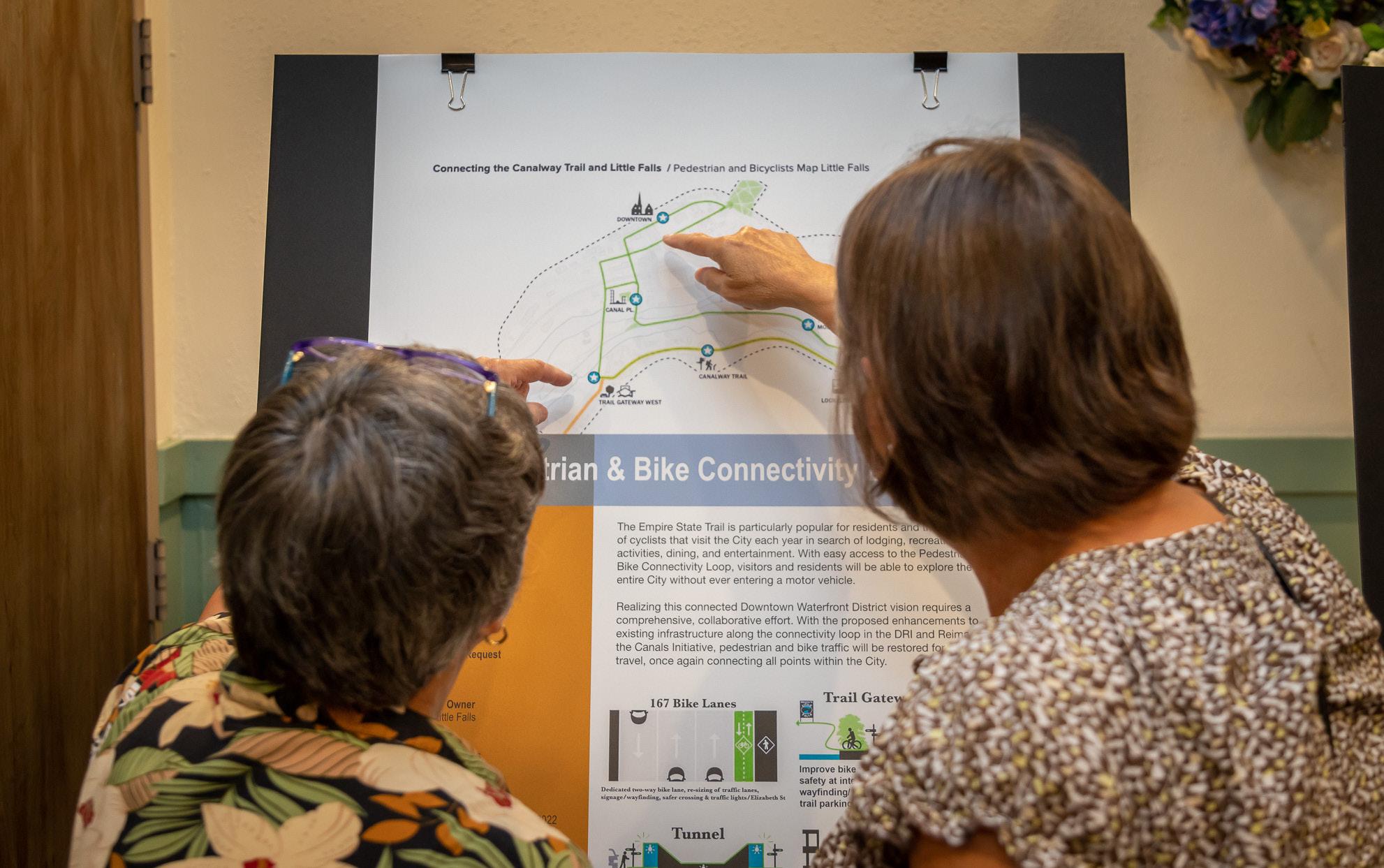

Public Support
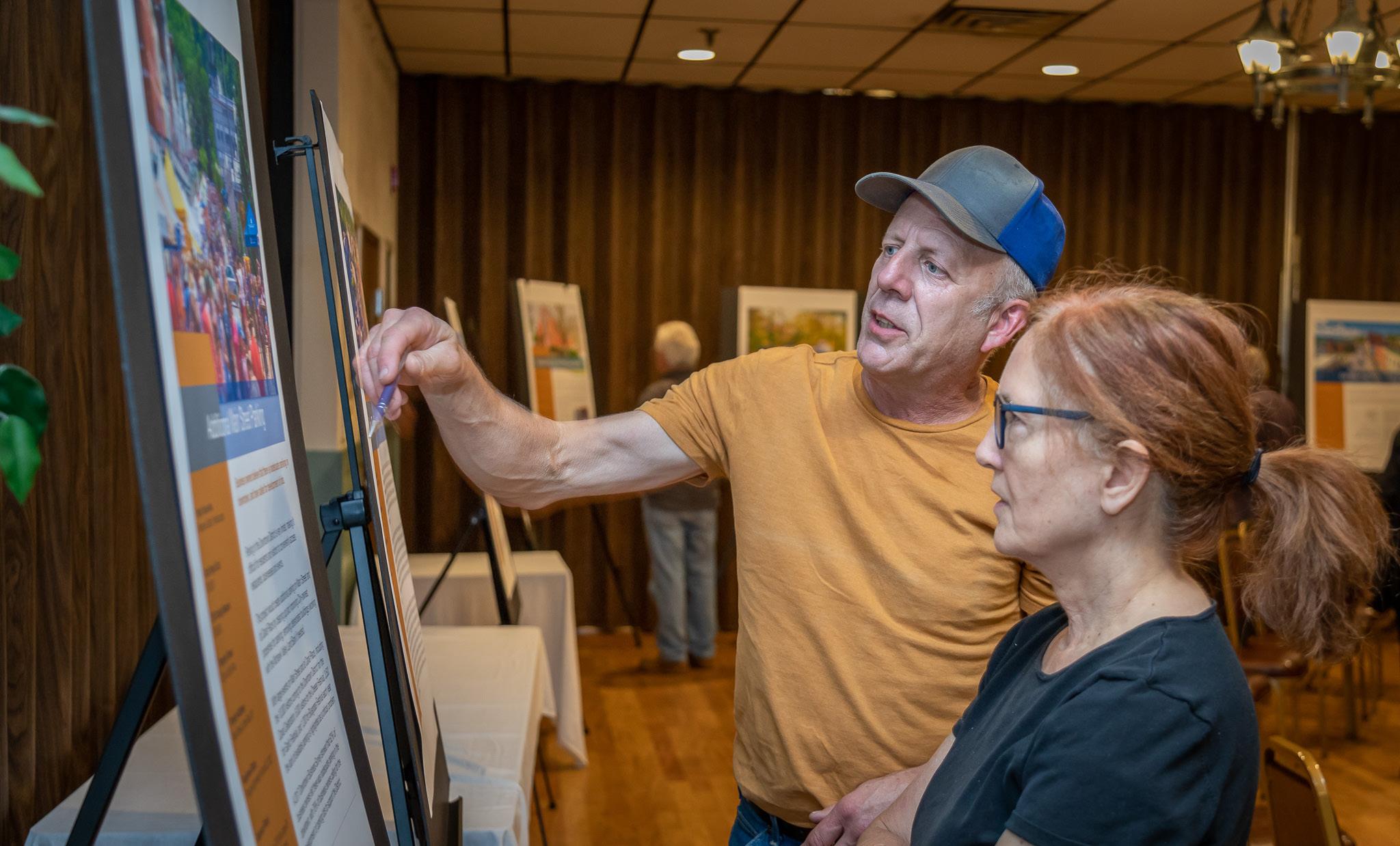
Two members of the community discuss one of the DRI projects during a community meeting.
Over the course of an eighteen-month (total period between 2020 and 2021) process, the Application Steering Committee and project partners engaged with stakeholders in multiple and varied settings, gathering input from downtown property and business owners and numerous community constituents. More than 110 people provided survey input as the plan was being developed via an online form, and approximately 75 attended either in-person or via “ Zoom a public presentation in August of 2021. Preliminary DRI concepts were presented in early Spring to district stakeholders, property owners, organizations, local officials and the Reimagine the Canal Initiative via Zoom calls, video presentations, and the www.littlefallsdri. com website. The vision framework and plan options were presented to garner feedback and support in anticipation of continued public engagement this summer.
I envision the Downtown Waterfront District ...
DRI Community Survey Input ...
DRI Application Steering Committee
Mark Blask Mayor, City of Little Falls
Chester P. Szymanski III, P.E. City Engineer, City of Little Falls
Joseph Wicks Special Projects Manager, The Community Foundation
David E. Warner Principle, Embella, Inc.
Deborah A. Kaufman Principle, Embella, Inc.
Proposed Local Planning Committee
Representatives from the following agencies, organizations and community sectors will be invited to join the DRI Local Planning Committee:
• City of Little Falls
• Herkimer County
• NYS Agencies
• The Community Foundation
• Embella, Inc.
• Transformational project partners
• Mohawk Valley Center for the Arts
• Canal Place Association
• Main Street First
• Think Local Little Falls
• Rock City Development
• Non-profit Organizations
• Financial Institutions
• Property Owners
• Community Residents

Administrative Capacity
The City of Little Falls will be the lead agency for this project, and the assigned consultants will work in coordination with the City’s Planning Department and Department of Urban and Economic Development. The Departments will be responsible for municipal project implementation using existing staff which includes the City Engineer, Codes Enforcement Officer, and others.
Transformational Projects Map & Narratives
Describe opportunities to build on the strengths described above by providing a list of transformative projects that could be ready for implementation with an infusion of DRI funds within the first one to two years (depending on the scope and complexity of the project). Identify potential development opportunities, such as municipally-owned property that may be appropriate for redevelopment. Projects may be public or private, and could address economic development, transportation, housing, and community development needs. It should be recognized that if a DRI award is made to the downtown, the projects identified here, along with any others that may arise during the DRI planning process, will ultimately be vetted by the Local Planning Committee and the State to determine which projects receive DRI grants.
The City of Little Falls DRI initiative encapsulates $29,370,000 in shovel-ready, transformative projects. The following twenty projects offer dramatic, quality-of-life improvements for the City’s current and future residents as well as visitors. Projects include: infrastructure enhancements, a pedestrian and bike loop connecting the district to the Empire State Trail by leveraging existing infrastructure, park enhancements to maximize space, increased lodging capacity, reopening historic event space, placemaking streetscape and public art, free citywide fiber and WiFi, Main Street enhancement and historic district funds, e-mobility, increased child care capacity and adaptive reuse of a historic asset.
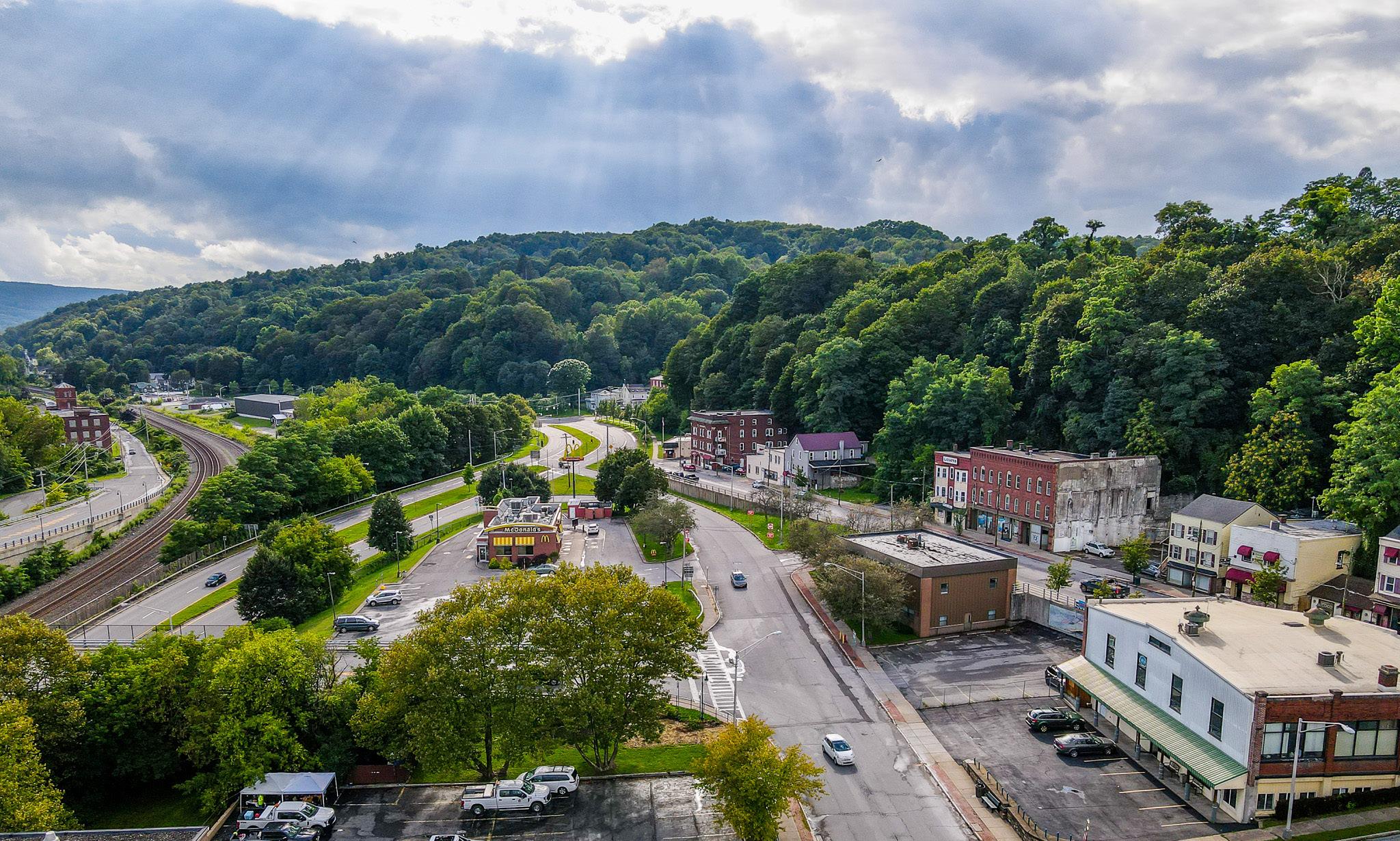
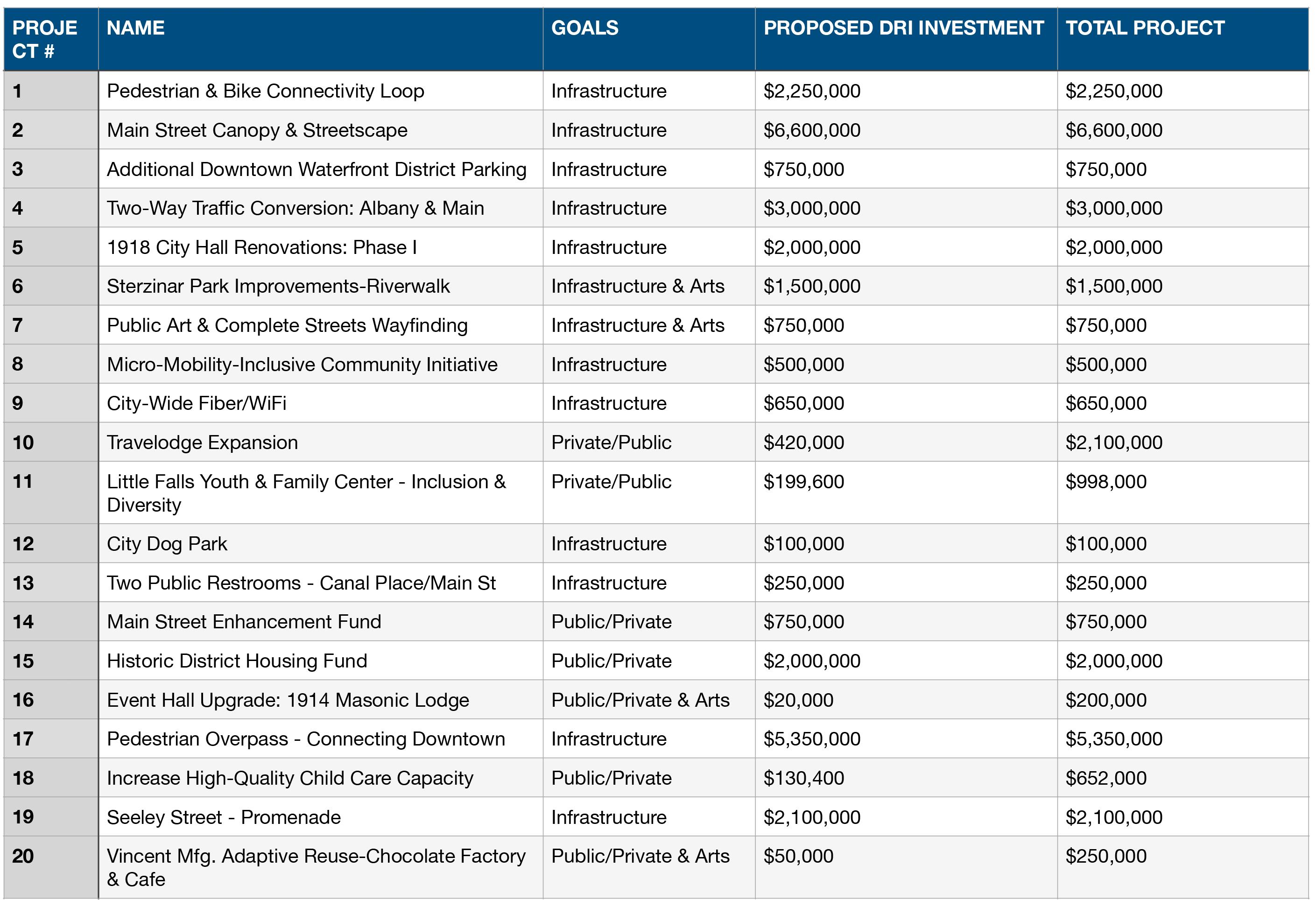
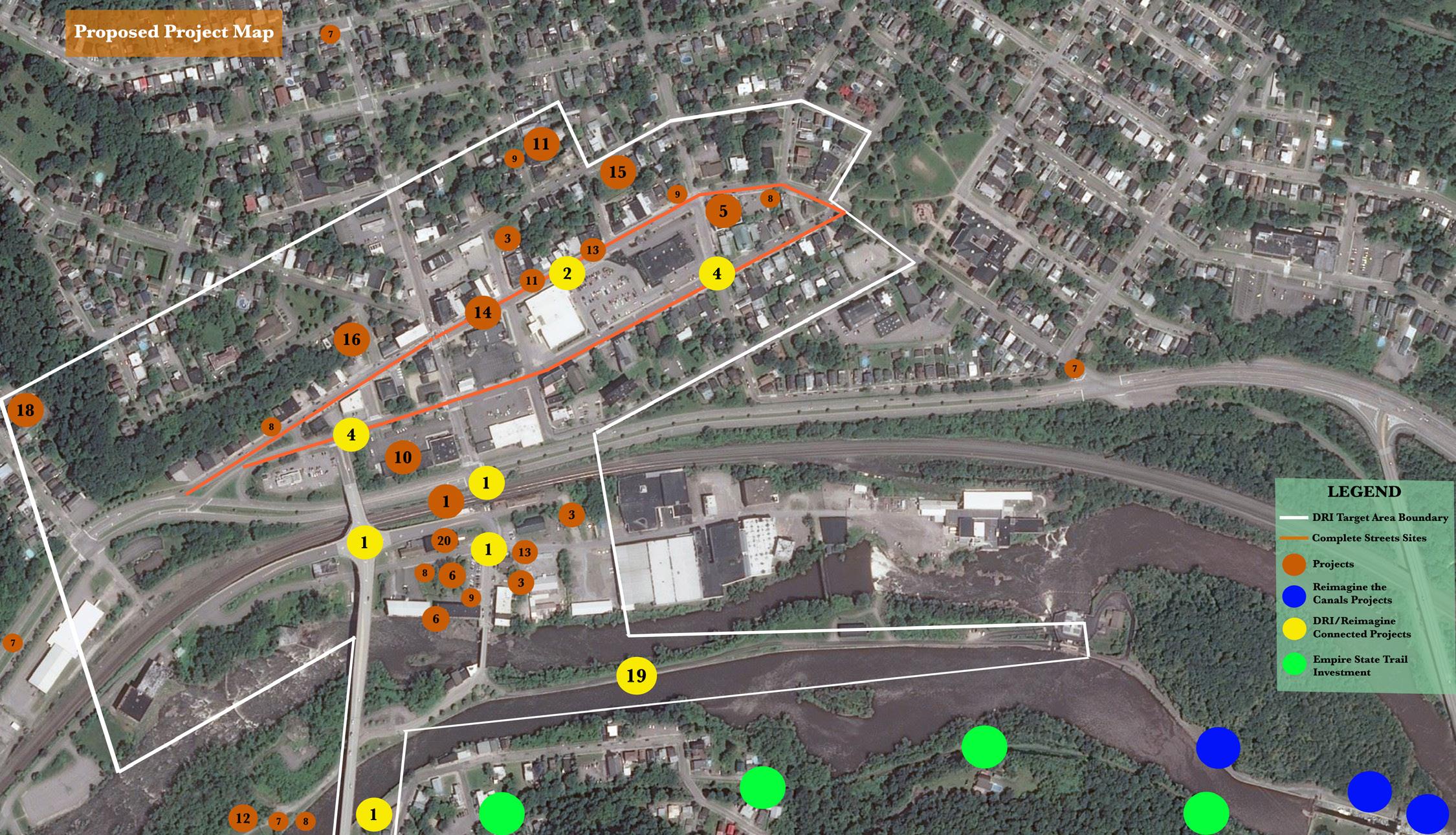


Pedestrian & Bike Connectivity Loop Renderings
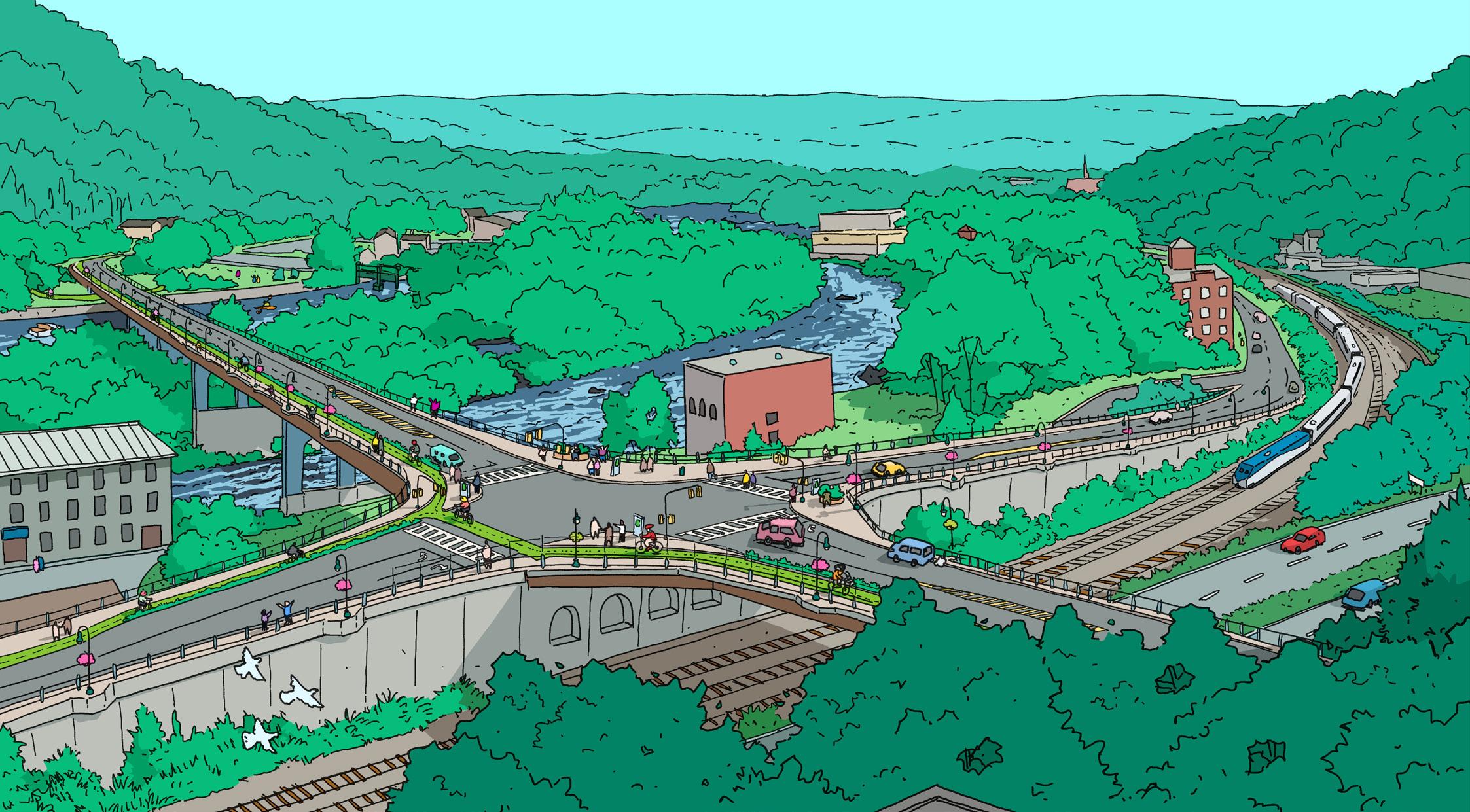
Dedicated two-way bike lane, re-sizing of traffic lanes, signage/wayfinding, safer crossing & traffic lights at Elizabeth Street and State Route 167.


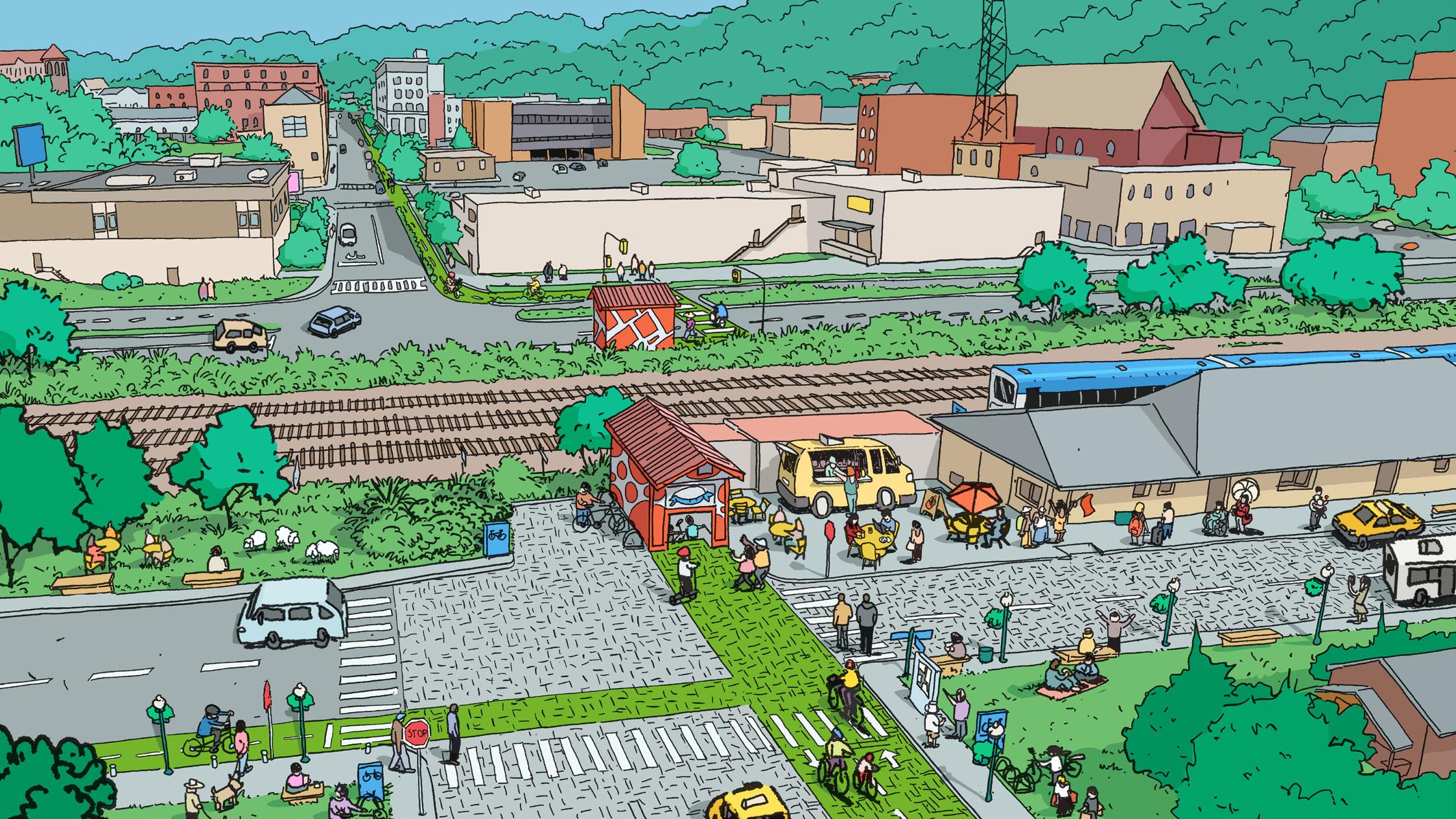
Renovate both entrances to the tunnel to be more inviting, clearly visible and more easily accessible for cyclists. Add new signage and directional wayfinding elements. Improve walking experience from underpass to Canal Place by re-paving sidewalk and streets. Add bike parking, rental station and street trees at Canal Place.
Future Scenarios / A day in the life of
Day trip:
...a resident going for a Sunday hike from Downtown to Canalway Trail and back via NY-167 overpass, meeting a friend in Eastern Park.. Travelled distance: 3.1 miles
MAIN STREET
DOWNTOWN
ALBANY STREET
ANN STREET EASTERN PARK
NY - 167
CANAL PL.
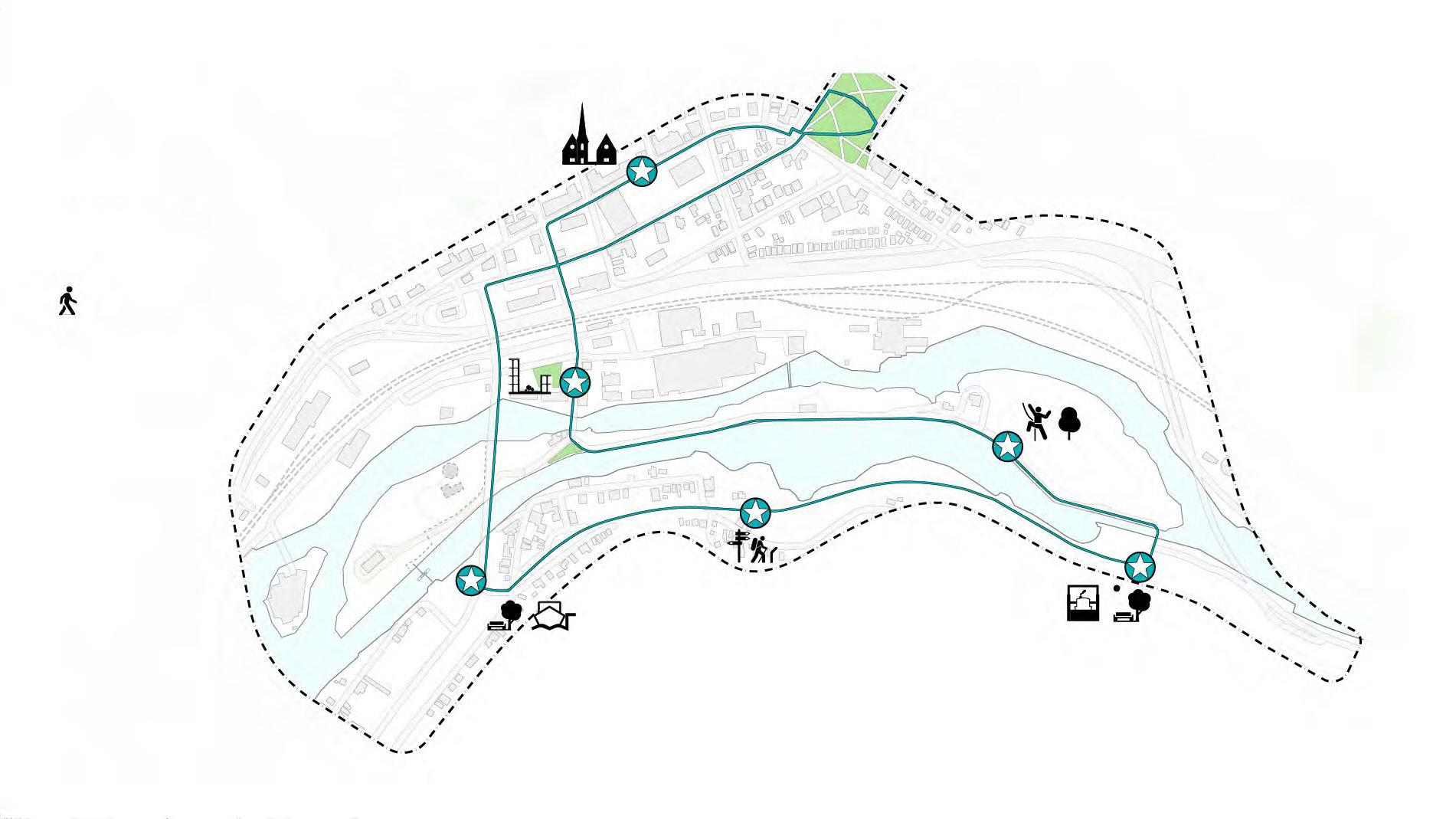
MOSS ISLAND
TRAIL GATEWAY WEST CANALWAY TRAIL
LOCK 17 PARK
200 500 1000
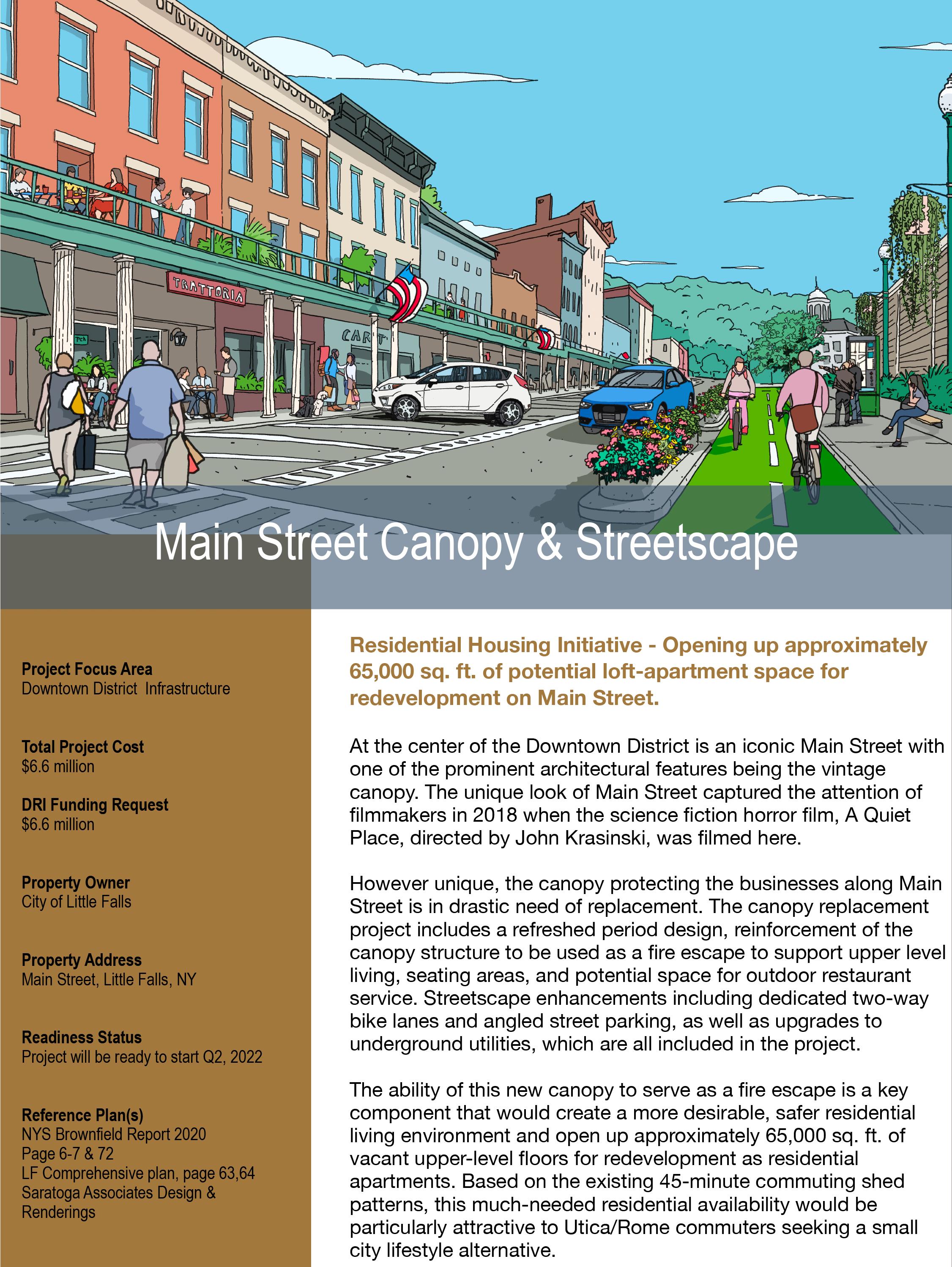

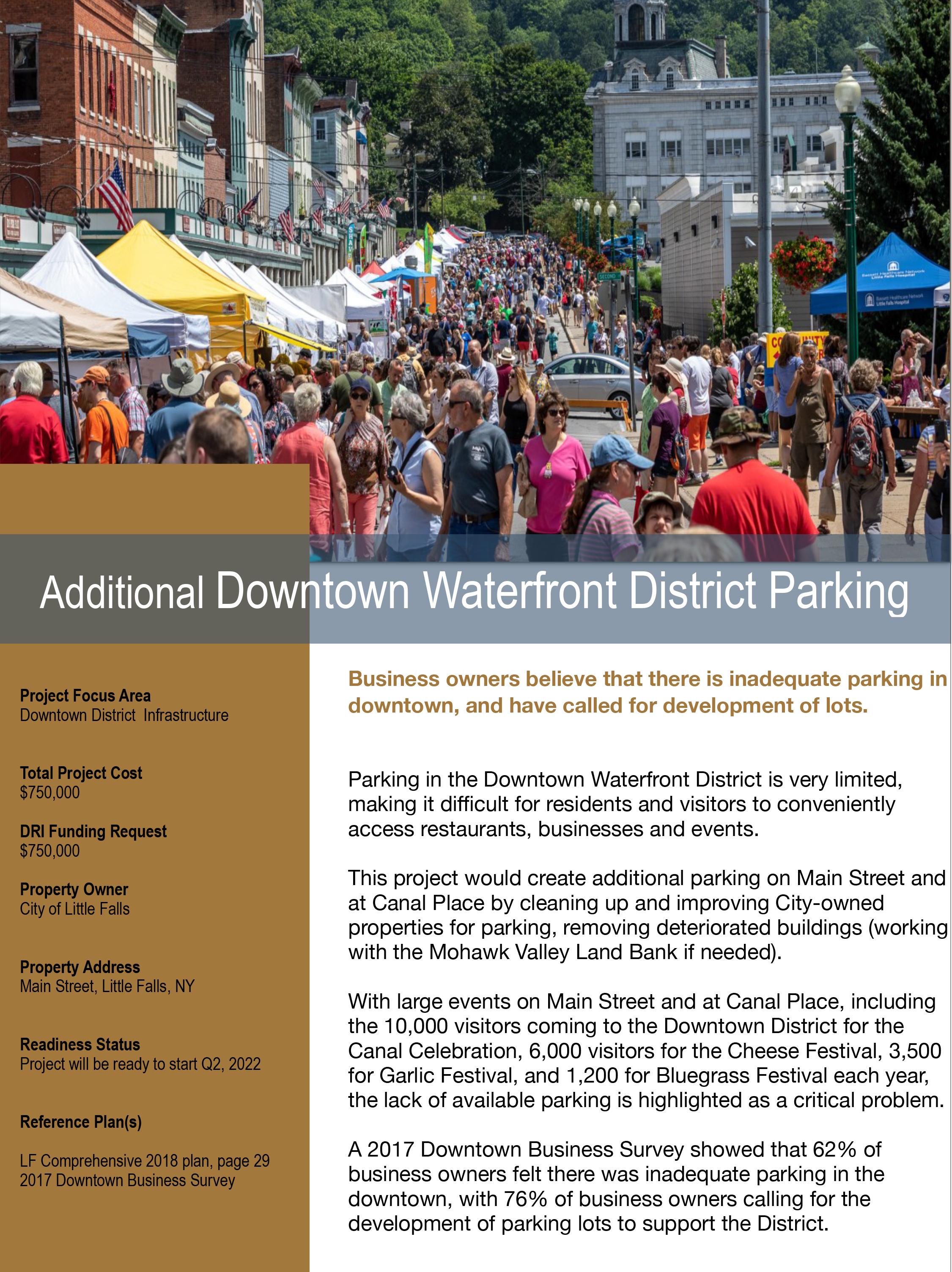
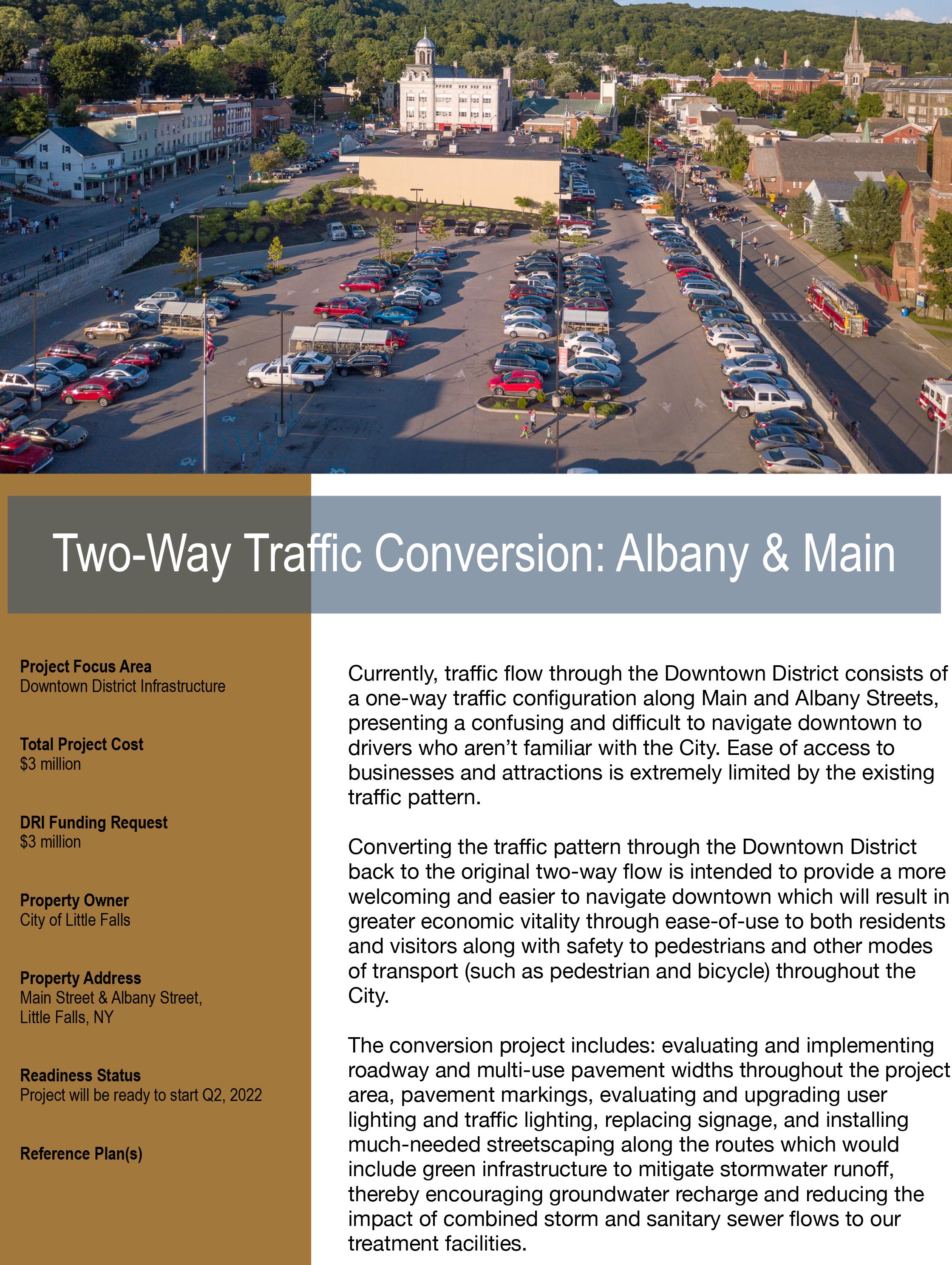

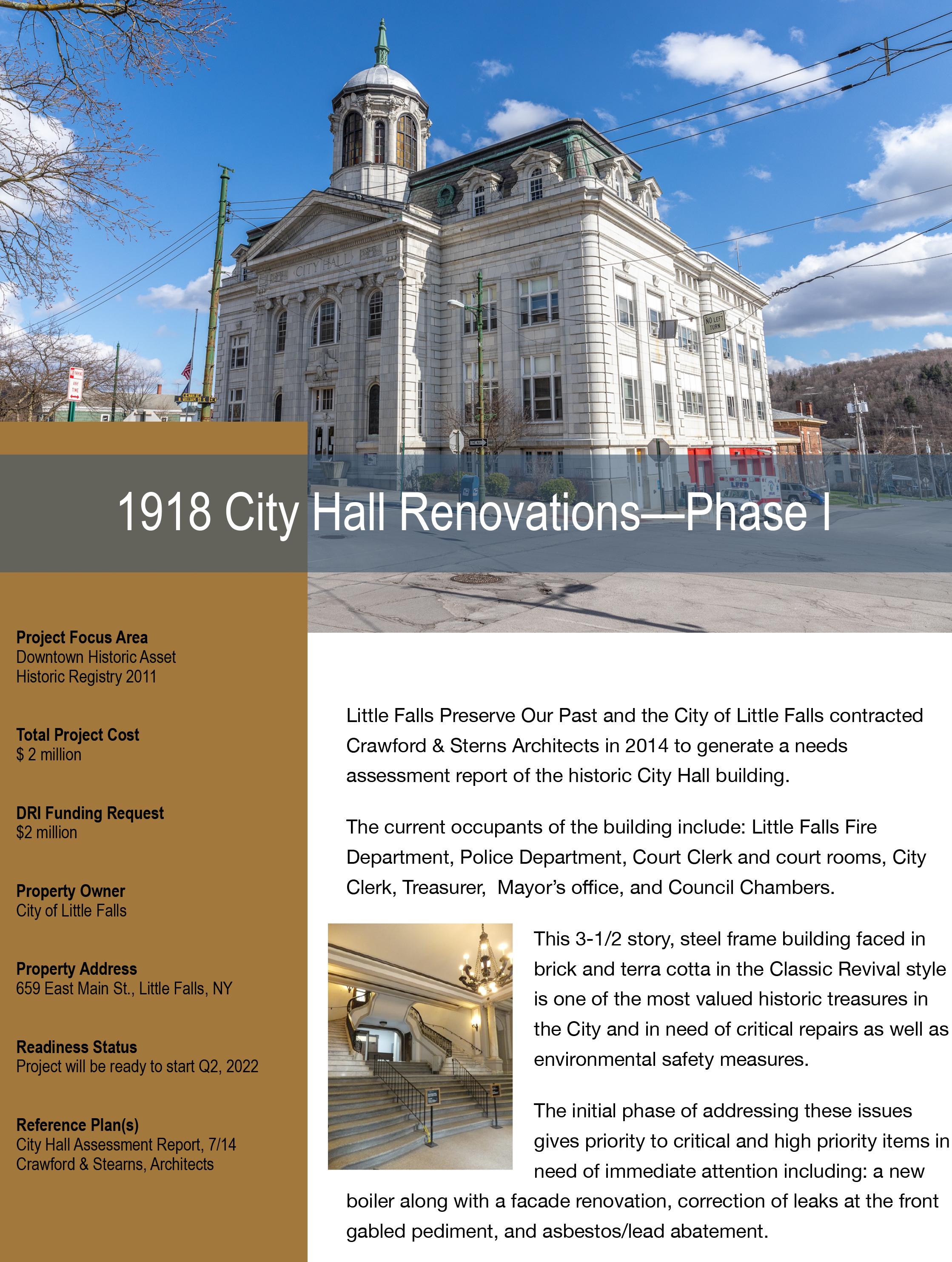
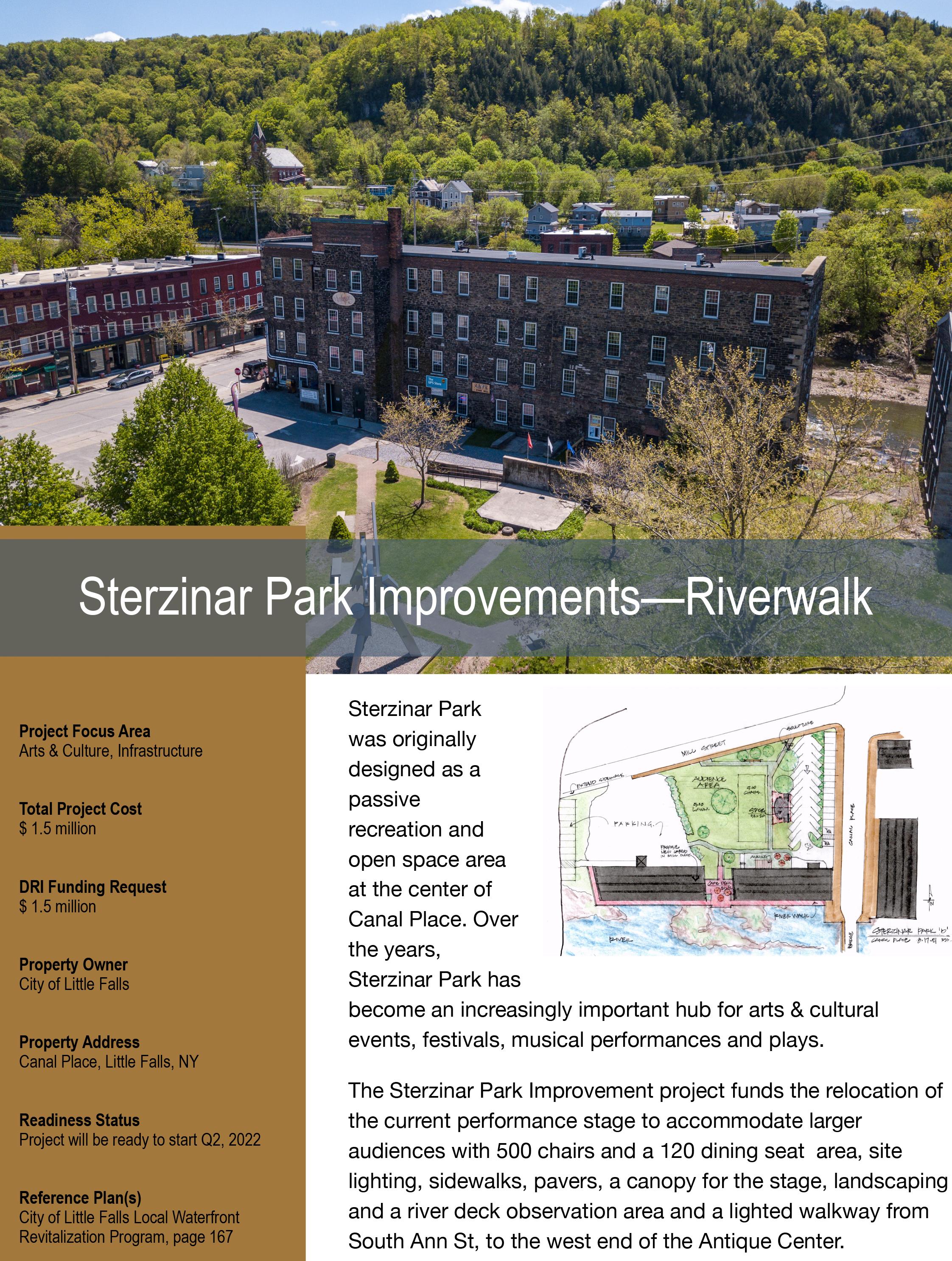


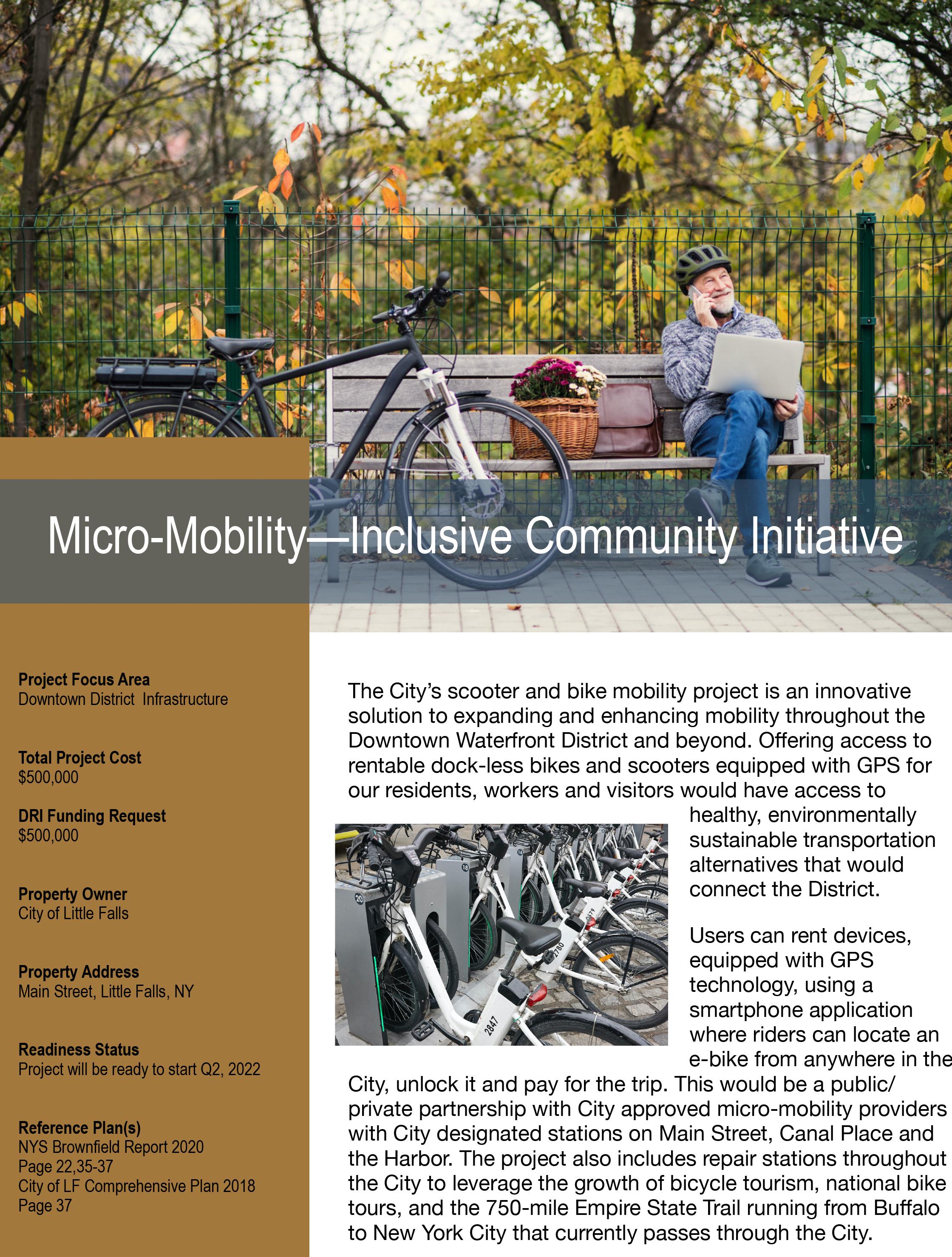

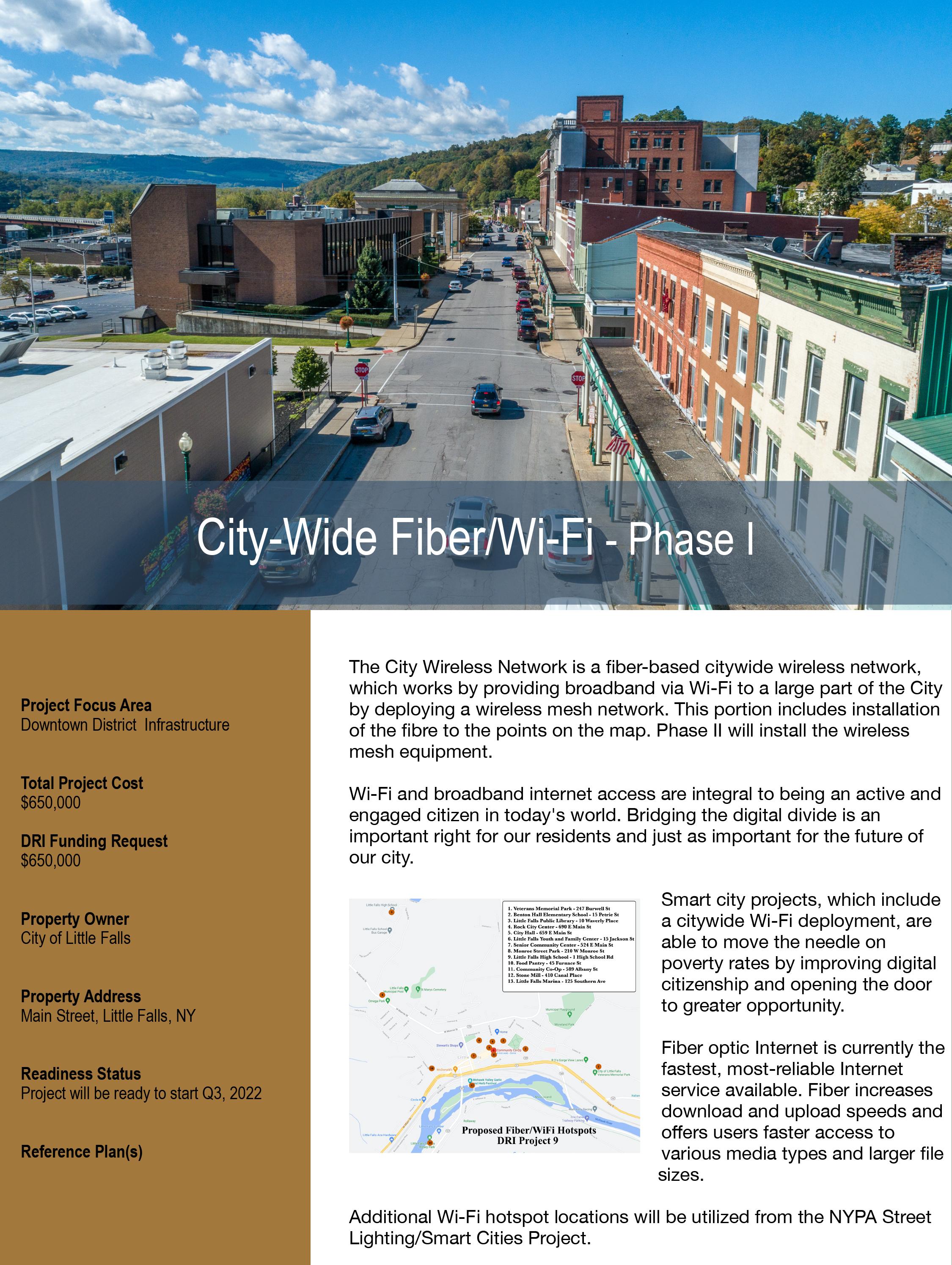
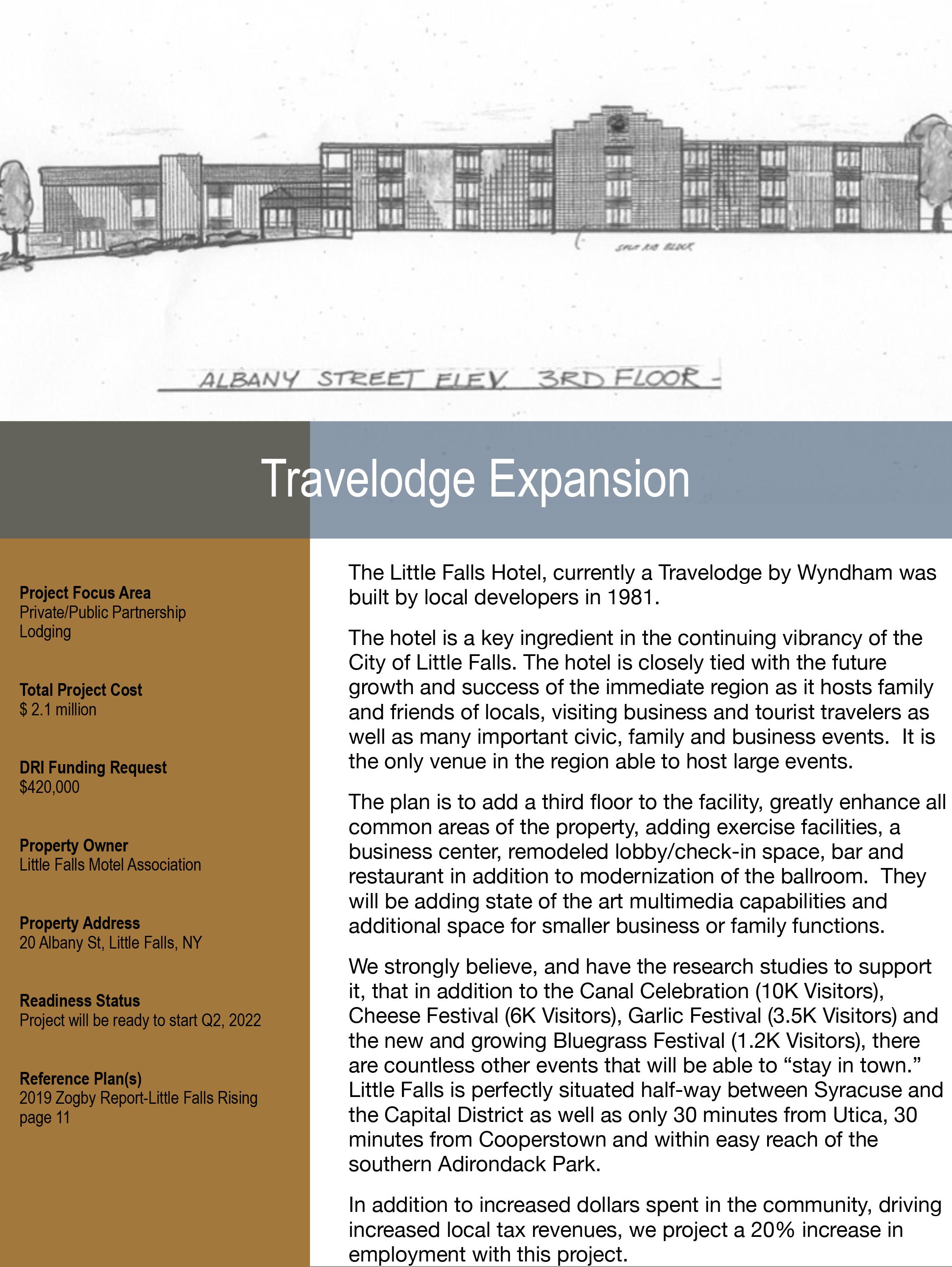

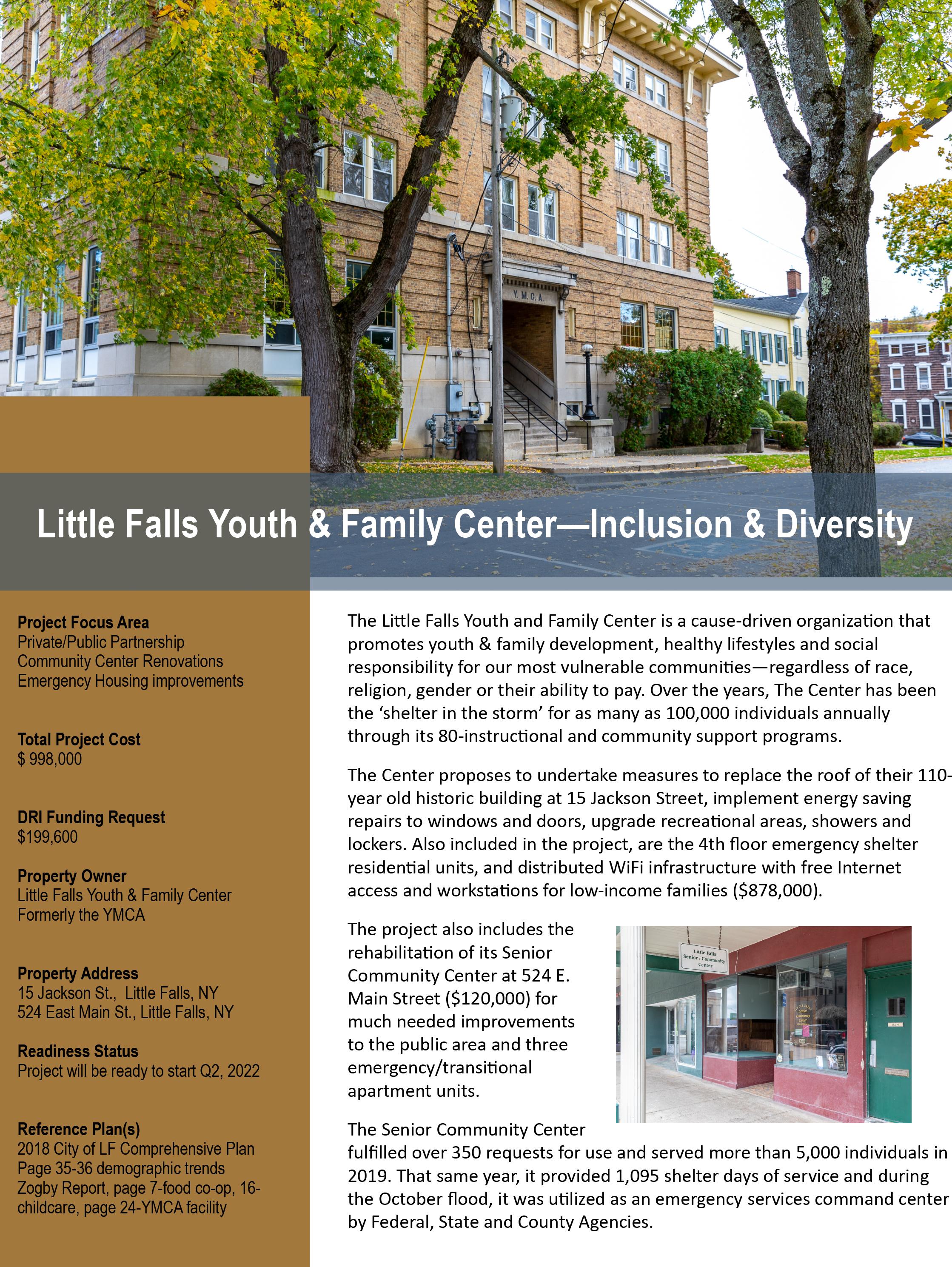
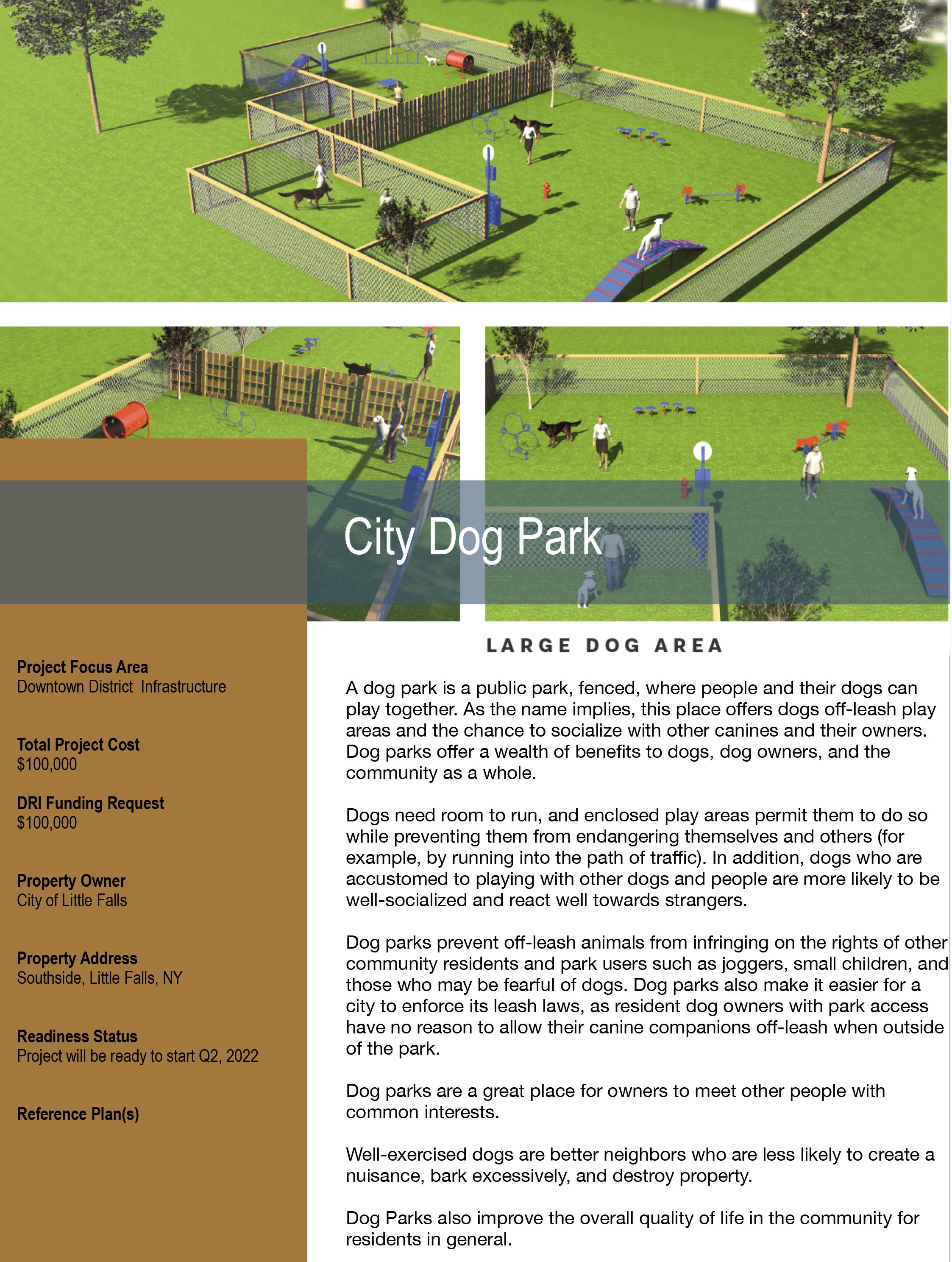


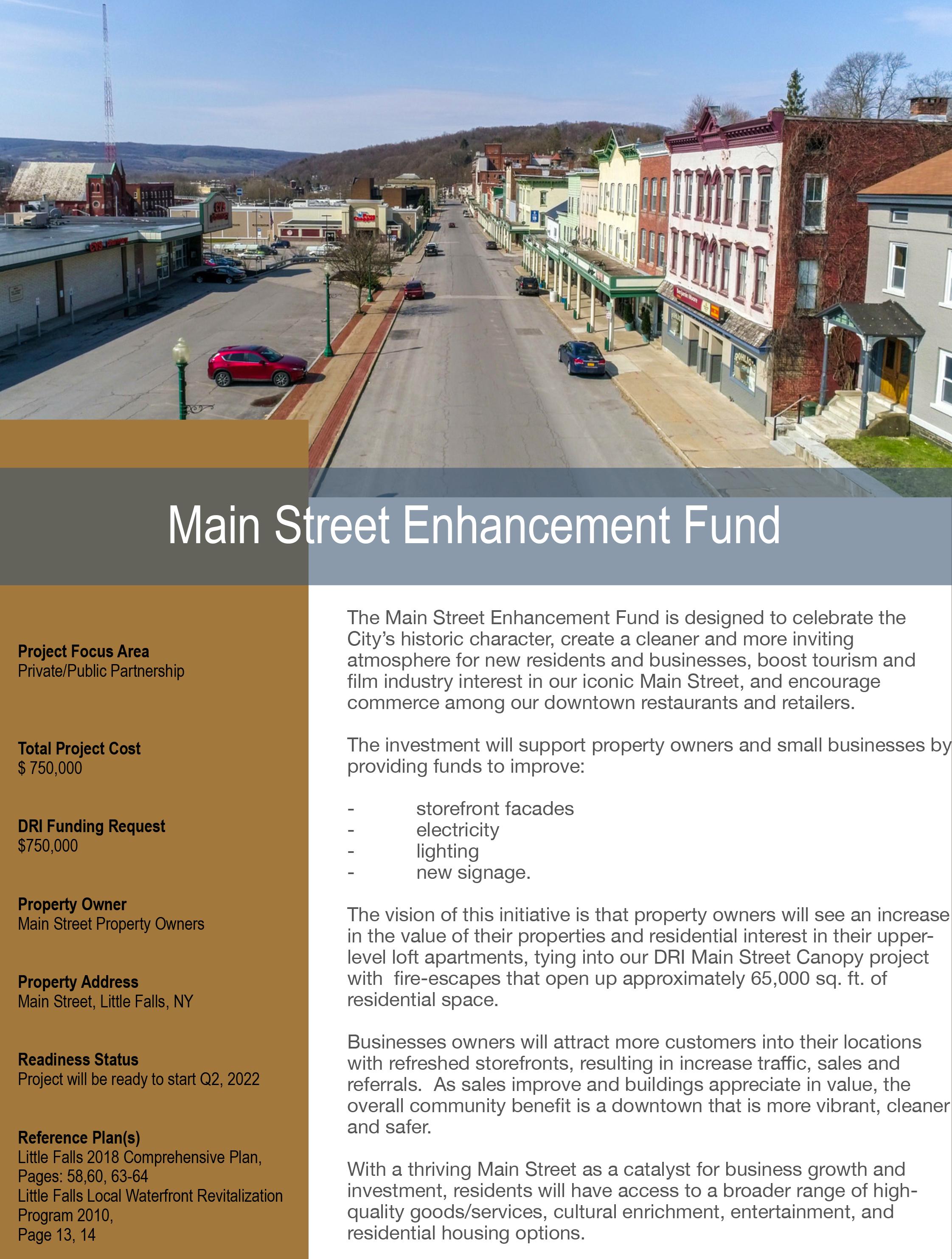

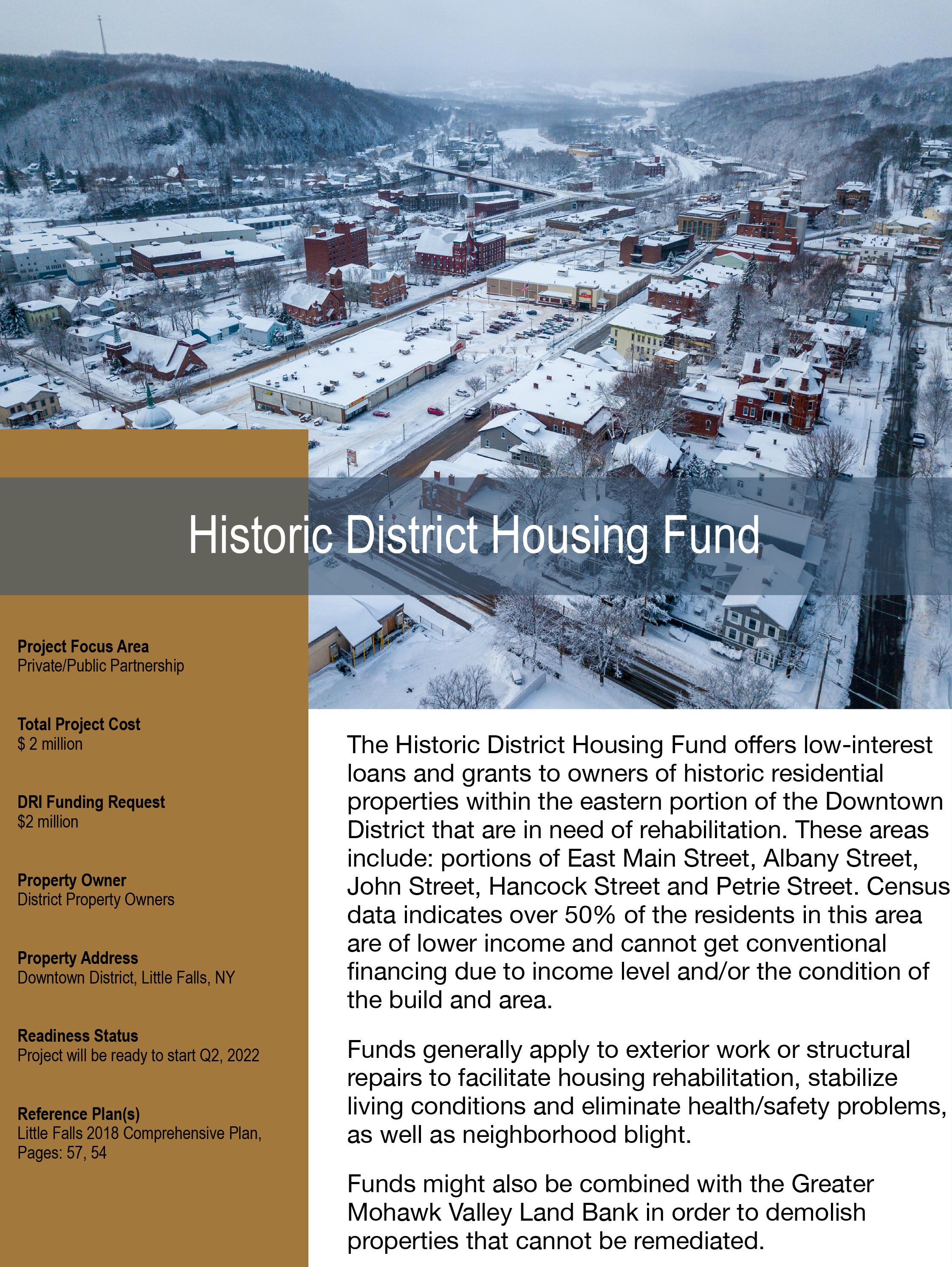
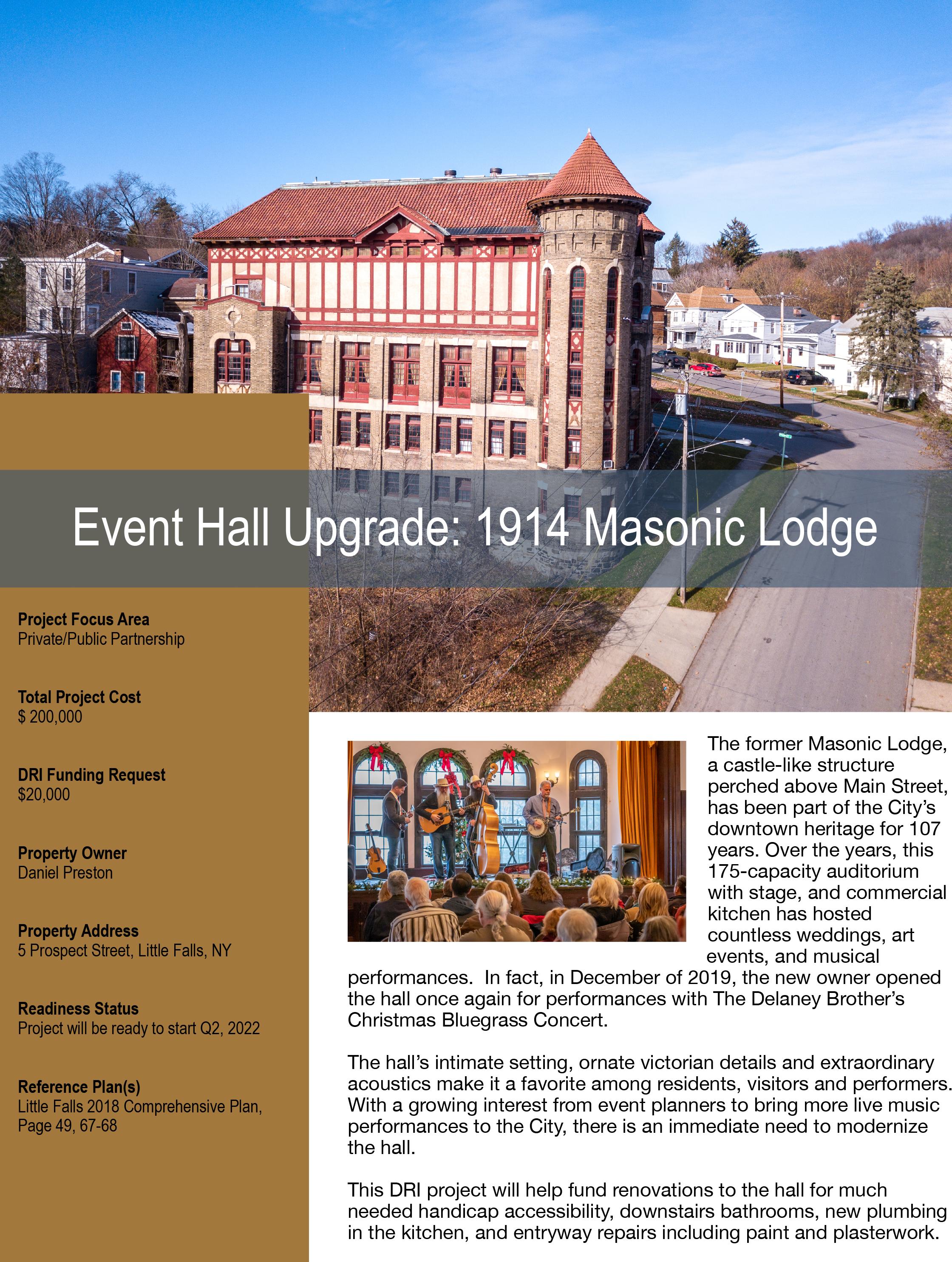

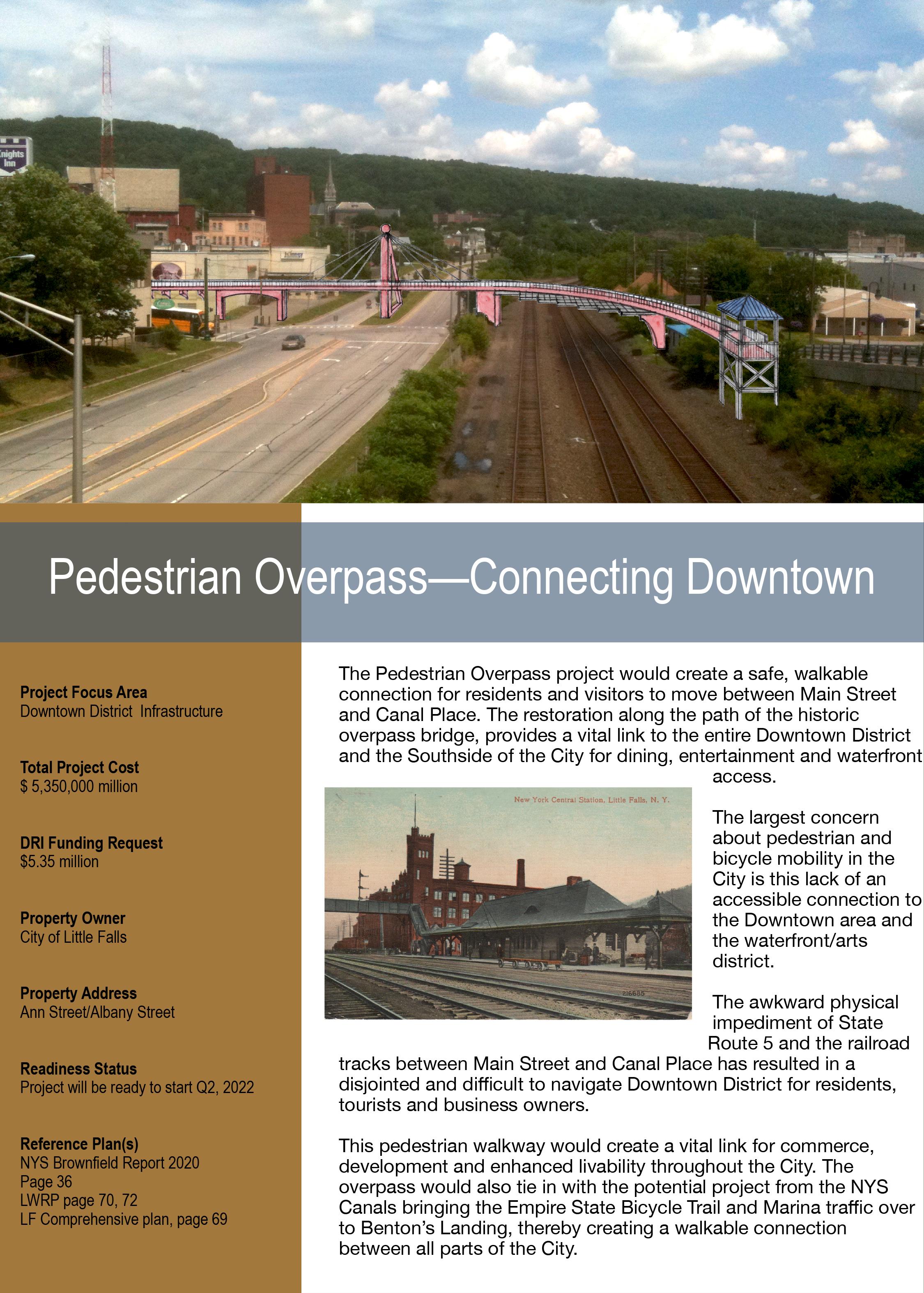
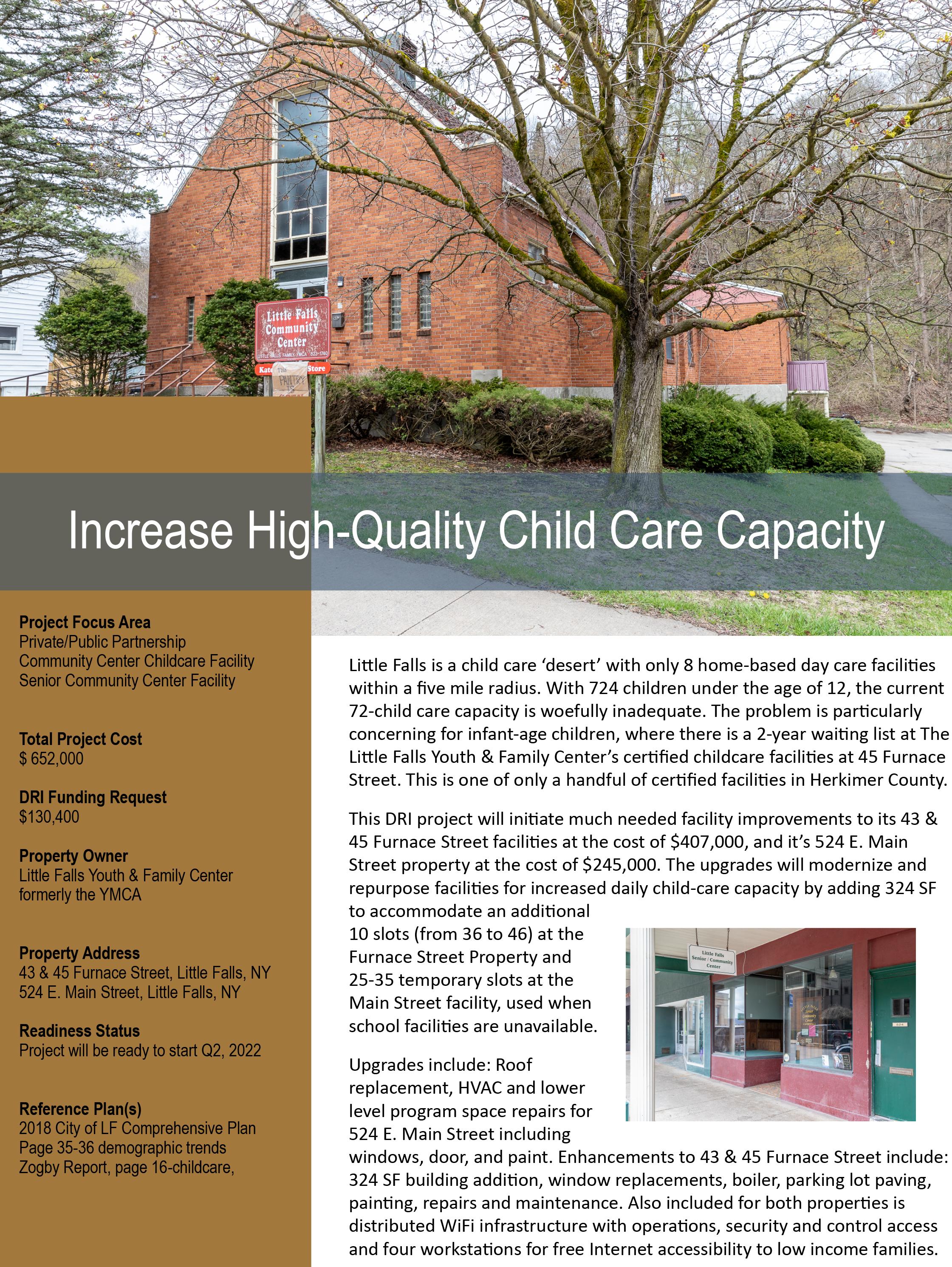


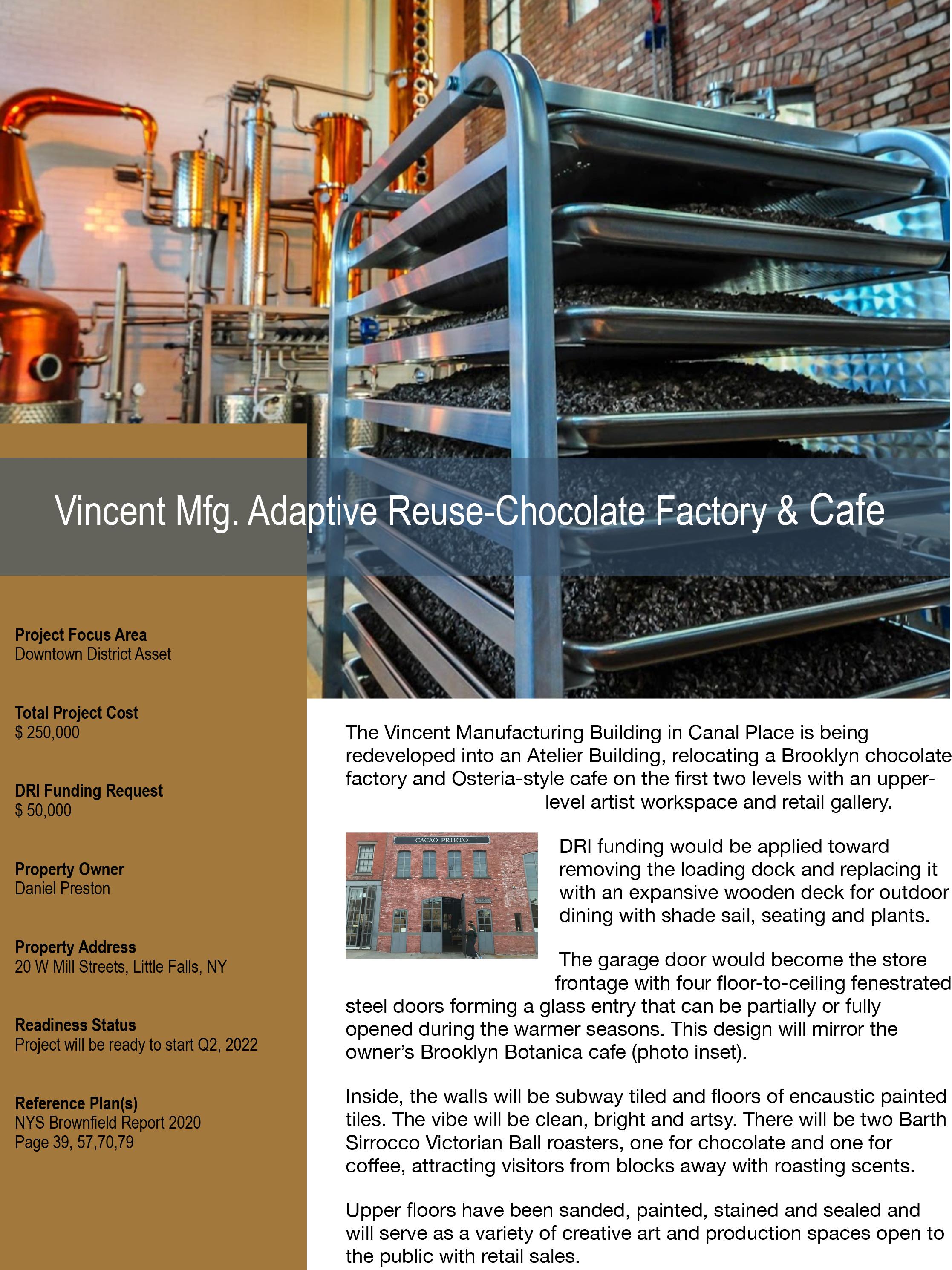

I envision the Downtown Waterfront District will...
DRI Community Survey Input ...
